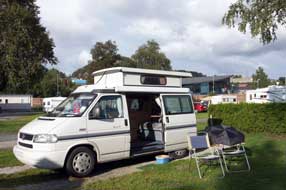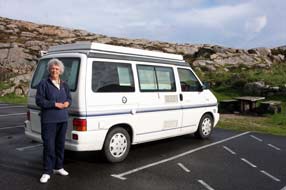|
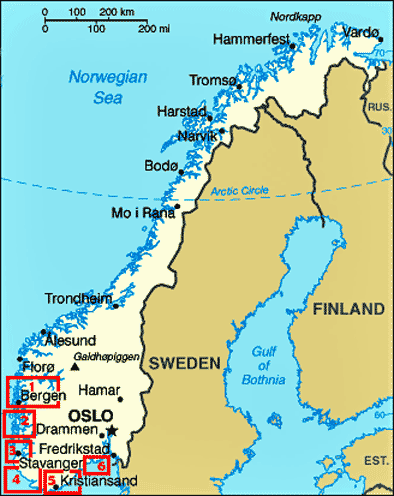 CAMPING
IN NORWAY 2014 - Port-city of Bergen, south-western coastal road, ferries and undersea tunnels
to Stavanger, Norway's southernmost point, Kristiansand, south coast to Langesund
for ferry back to Denmark: CAMPING
IN NORWAY 2014 - Port-city of Bergen, south-western coastal road, ferries and undersea tunnels
to Stavanger, Norway's southernmost point, Kristiansand, south coast to Langesund
for ferry back to Denmark:
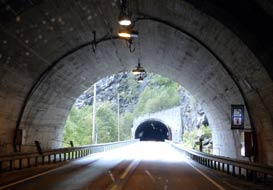 Stalheim and its view down into Nærøydalen:
leaving Vang Camping in the murky depths of Nærøydalen, we drove up this
magnificent valley with its high mountain side-walls still partly
obscured by cloud (Photo
1 - Nærøydalen). The valley-head was dominated by a scree-lined, conical
outcrop-peak, and as we climbed higher, there ahead on a high shelf we could
just make out the red wooden buildings of the Stalheim Hotel peering down into
the valley way below. The modern E16 negotiates the valley head-wall via two
curving tunnels; before their construction in the 1980s, the old road branched
off from the valley floor climbing the brutally steep slope by an endless series
of hair-pins on a astonishing gradient of 18%. The Stalheimskleiva old road,
Northern Europe's steepest, was then the only route up out of Nærøydalen.
Stalheim Hotel at the top of the Stalheimskleiva hair-pins was a stopping-off
point on the former Mail Road from Oslo to Bergen, where mail-coaches
had a much-needed changed horses after climbing up from the valley. This old road, which was
replaced by the modern tunnels, continues to be used as a tourist route with airy views from its hairpins down the length of Nærøydalen. Stalheim and its view down into Nærøydalen:
leaving Vang Camping in the murky depths of Nærøydalen, we drove up this
magnificent valley with its high mountain side-walls still partly
obscured by cloud (Photo
1 - Nærøydalen). The valley-head was dominated by a scree-lined, conical
outcrop-peak, and as we climbed higher, there ahead on a high shelf we could
just make out the red wooden buildings of the Stalheim Hotel peering down into
the valley way below. The modern E16 negotiates the valley head-wall via two
curving tunnels; before their construction in the 1980s, the old road branched
off from the valley floor climbing the brutally steep slope by an endless series
of hair-pins on a astonishing gradient of 18%. The Stalheimskleiva old road,
Northern Europe's steepest, was then the only route up out of Nærøydalen.
Stalheim Hotel at the top of the Stalheimskleiva hair-pins was a stopping-off
point on the former Mail Road from Oslo to Bergen, where mail-coaches
had a much-needed changed horses after climbing up from the valley. This old road, which was
replaced by the modern tunnels, continues to be used as a tourist route with airy views from its hairpins down the length of Nærøydalen.
|
Click on 6 highlighted areas of map for
details of
SW Norway |
 |
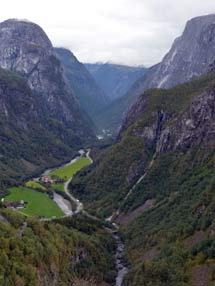 Because tour-buses regularly, and totally
improbably, negotiate this single-track, winding road down the 18% hair-pins, the
old route is now restricted to one-way down only. Paul must have travelled this
way pre-tunnels in 1968 on the service bus from Voss for the ferry down Nærøyfjord from Gudvangen to Kaupanger, though he has only limited recollections
of journey and its startling views. Today in our camper we took the modern road
up through the tunnels (see above left),
with E16 curving round at a steep gradient (but certainly not 18%!), to emerge
just before the turning into the upper section of the Stalheimskleiva. We turned
into this
single-track lane which climbed for 2kms to reach the modern Stalheim Hotel where
Paul's bus in 1968 must have stopped before descending the Stalheimskleiva
hair-pins. Through binoculars we could just make out today the precipitous path
up to the Husmannsplassen Nåli mountain farm high on the mountainside above the
sheer drop down into Nærøydalen. The farm had been occupied until 1930, and its
approach path now serves as a severe walking route, but not for vertigo
sufferers! The hotel staff responded with graceful courtesy to our hesitant
enquiry about access to the terrace overlooking Nærøydalen: yes of course, they
said, and the view from the wall of the terrace garden, perched on the edge of
the high shelf was beyond description (Photo 2 - Nærøydalen from Myrdal Hotel terrace). This vantage point high above the valley
gave admirable views looking directly down into the depths of Nærøydalen (see
left); it was such a pity that in this morning's gloomy weather, the mountains and
valley-bottom were obscured by the poor light, with the weak sun just breaking
through failing to penetrate to the valley floor so far below. Peering over the wall,
we could just see the modern E16 road emerging from the top tunnel portal, and
away to our left even today tour buses were tentatively edging down from the top
of the Stalheimskleiva hair-pins - sheer madness! As we returned to George, a
thought of horror struck us: did the one-way restriction on the old road extend
also to the top section, and were we therefore compelled to continue Because tour-buses regularly, and totally
improbably, negotiate this single-track, winding road down the 18% hair-pins, the
old route is now restricted to one-way down only. Paul must have travelled this
way pre-tunnels in 1968 on the service bus from Voss for the ferry down Nærøyfjord from Gudvangen to Kaupanger, though he has only limited recollections
of journey and its startling views. Today in our camper we took the modern road
up through the tunnels (see above left),
with E16 curving round at a steep gradient (but certainly not 18%!), to emerge
just before the turning into the upper section of the Stalheimskleiva. We turned
into this
single-track lane which climbed for 2kms to reach the modern Stalheim Hotel where
Paul's bus in 1968 must have stopped before descending the Stalheimskleiva
hair-pins. Through binoculars we could just make out today the precipitous path
up to the Husmannsplassen Nåli mountain farm high on the mountainside above the
sheer drop down into Nærøydalen. The farm had been occupied until 1930, and its
approach path now serves as a severe walking route, but not for vertigo
sufferers! The hotel staff responded with graceful courtesy to our hesitant
enquiry about access to the terrace overlooking Nærøydalen: yes of course, they
said, and the view from the wall of the terrace garden, perched on the edge of
the high shelf was beyond description (Photo 2 - Nærøydalen from Myrdal Hotel terrace). This vantage point high above the valley
gave admirable views looking directly down into the depths of Nærøydalen (see
left); it was such a pity that in this morning's gloomy weather, the mountains and
valley-bottom were obscured by the poor light, with the weak sun just breaking
through failing to penetrate to the valley floor so far below. Peering over the wall,
we could just see the modern E16 road emerging from the top tunnel portal, and
away to our left even today tour buses were tentatively edging down from the top
of the Stalheimskleiva hair-pins - sheer madness! As we returned to George, a
thought of horror struck us: did the one-way restriction on the old road extend
also to the top section, and were we therefore compelled to continue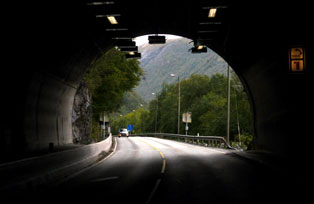 downwards
via the hair-pins? Common sense, or at least our interpretation of it, said
otherwise, and we carefully returned the way we had come up, back to re-join E16 westwards. downwards
via the hair-pins? Common sense, or at least our interpretation of it, said
otherwise, and we carefully returned the way we had come up, back to re-join E16 westwards.
The unremarkable town of Voss: the road wound its way along
rocky-sided valleys and past lakes, to approach the small town of Voss. Paul had
changed from the Bergen train here for the onwards service bus in 1968, but had
no recollections of the town; parking in the town centre, it was soon clear why
Voss should have made no memorable impressions. Yet another small Norwegian town
bombed to total destruction by the German invaders in 1940, the modern rebuilt
Voss was one of the most un-noteworthy places we had seen on our travels through
Norway. Not even the 13th century church left any impressions, and we drove
through the rather grubby centre, around the lake and continued on towards
Bergen.
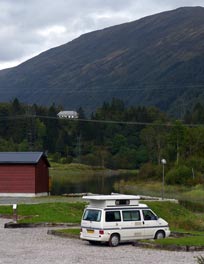 Bratland Camping, the closest campsite to
Bergen: the E16 road and
railway line ran in parallel along a rocky valley above river and lakes, passing
through an amazing total of 22 tunnels of between 500m and 2kms in length (see
above right) (Photo 3 - E16 tunnels)
on the winding 50kms route westwards towards Bergen. Partway it reached an inner arm of Veafjord and continued along a shelf above the fjord-shore finally reaching the
small town of Indre Arna; here, after a long and tedious drive from Voss
constantly in and out of tunnels, we turned off onto Route 580 for 10kms to
reach Bratland Camping. We had been unable to find any other campsite within close
proximity to Bergen; Bratland 16kms out was the best of a poor selection but at
least was on a regular public transport route into the city. Even so we had no
great expectations about the place which inevitably would be expensive. The moment we
arrived, it was clear that the campsite's worst feature was its proximity to the
adjacent Route 580; although seemingly a minor road, this was in fact a bypass
route around the southern side of the city linking to E16, and therefore busy
with heavy traffic which swamped the campsite with the roar of traffic noise. We
had no other options and booked in at reception where the owners did at least receive us Bratland Camping, the closest campsite to
Bergen: the E16 road and
railway line ran in parallel along a rocky valley above river and lakes, passing
through an amazing total of 22 tunnels of between 500m and 2kms in length (see
above right) (Photo 3 - E16 tunnels)
on the winding 50kms route westwards towards Bergen. Partway it reached an inner arm of Veafjord and continued along a shelf above the fjord-shore finally reaching the
small town of Indre Arna; here, after a long and tedious drive from Voss
constantly in and out of tunnels, we turned off onto Route 580 for 10kms to
reach Bratland Camping. We had been unable to find any other campsite within close
proximity to Bergen; Bratland 16kms out was the best of a poor selection but at
least was on a regular public transport route into the city. Even so we had no
great expectations about the place which inevitably would be expensive. The moment we
arrived, it was clear that the campsite's worst feature was its proximity to the
adjacent Route 580; although seemingly a minor road, this was in fact a bypass
route around the southern side of the city linking to E16, and therefore busy
with heavy traffic which swamped the campsite with the roar of traffic noise. We
had no other options and booked in at reception where the owners did at least receive us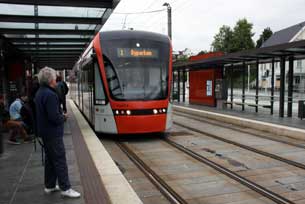 with due courtesy and help with city street plan and public transport details. The
difficulty then was to find a viable pitch: the campsite was divided into
several small gravelled camping areas, but the least unattractive was inevitably
closest to the main road and traffic noise. A lot of effort had been put into
creating bays in each area, but the bays were unduly restricted in size even for
a small camper like George, with risk of catching doors
on the raised side-walls (see left). But even worse was the absence of a level surface; we
tried all the areas without success, eventually settling down by the road as the
least unsatisfactory despite the traffic noise. On top of all of this, Bratland's
facilities were ill-designed and dysfunctional; it was a hopeless site. We took
stock: despite having allowed 2 days for visiting Bergen, it was an unappealing
city with over-expensive museums; this and the traffic-ridden campsite meant we should confine our time in
Bergen to just one day.
with due courtesy and help with city street plan and public transport details. The
difficulty then was to find a viable pitch: the campsite was divided into
several small gravelled camping areas, but the least unattractive was inevitably
closest to the main road and traffic noise. A lot of effort had been put into
creating bays in each area, but the bays were unduly restricted in size even for
a small camper like George, with risk of catching doors
on the raised side-walls (see left). But even worse was the absence of a level surface; we
tried all the areas without success, eventually settling down by the road as the
least unsatisfactory despite the traffic noise. On top of all of this, Bratland's
facilities were ill-designed and dysfunctional; it was a hopeless site. We took
stock: despite having allowed 2 days for visiting Bergen, it was an unappealing
city with over-expensive museums; this and the traffic-ridden campsite meant we should confine our time in
Bergen to just one day.
Our visit to the port-city of Bergen:
the following morning we walked around to the bus stop for the half-hourly
#90 bus service into Nestun, an outer suburb of the city. Here we changed to the
Bergen Light Railway (By-banen) (Photo 4 - Bergen tram)
(see above right) for the 25 minute ride on the fast and modern tram-line into the centre; the one ticket bought on the bus at 21 NOK honnør
(seniors') reduced price was valid for the whole journey. The By-banen tram-line
reached its terminus in the city centre by a small park, where we alighted to
get our bearings.
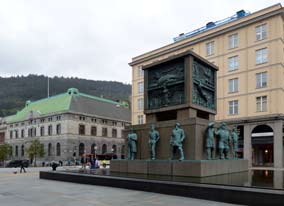 Bergen's history: Bergen was founded in 1070 by King Olaf Kyrre
(the Peaceful), son of Harald Hardråde and survivor of the 1066 Battle of
Stanford Bridge, and became the most important of Medieval Norway's towns and
the royal residence. In the 13th century, the mercantile city joined the
Hanseatic Trading League. German merchants settled here, setting up their first
office in Bergen in 1360 and transforming the wharf-side Bryggen into one of the
League's 4 major headquarters abroad. For some 400 years Bryggen was ruled by
this tight-knit community of some 2,000 German resident traders who imported
grain and food-stuffs and exported dried fish. German economic strength
dominated the region, reducing local interests to a state of dependency. By then
the Norwegian seat of royal authority had moved to Oslo, and was more than
content to gather the easily collected tax revenues from the Hansa guild of
German merchants, even compelling west-coast fishermen to sell their catch to
the merchants at prices dictated by the merchants themselves. By the 15th
century, competition from Dutch and English shipping companies began the
Hanseatic League's decline, but even in the 17/18th centuries Bergen was still
the trading hub of Scandinavia with Bergen remaining an important maritime
trading centre until the Hanseatic League's Bergen office finally closed in
1899. German and later Norwegian mercantile trading interests had flourished at
Bergen as a self-regulating trading station, enriching its merchants at the
expense of local fishermen. Today Bryggen still flourishes but now as the
centre-piece of Bergen's mass tourism industry, with cruise ships lining the
quays of the outer Vågen harbour beyond the remains of the Bergenhus Festning
(Fortress) which once dominated the port. Bergen's history: Bergen was founded in 1070 by King Olaf Kyrre
(the Peaceful), son of Harald Hardråde and survivor of the 1066 Battle of
Stanford Bridge, and became the most important of Medieval Norway's towns and
the royal residence. In the 13th century, the mercantile city joined the
Hanseatic Trading League. German merchants settled here, setting up their first
office in Bergen in 1360 and transforming the wharf-side Bryggen into one of the
League's 4 major headquarters abroad. For some 400 years Bryggen was ruled by
this tight-knit community of some 2,000 German resident traders who imported
grain and food-stuffs and exported dried fish. German economic strength
dominated the region, reducing local interests to a state of dependency. By then
the Norwegian seat of royal authority had moved to Oslo, and was more than
content to gather the easily collected tax revenues from the Hansa guild of
German merchants, even compelling west-coast fishermen to sell their catch to
the merchants at prices dictated by the merchants themselves. By the 15th
century, competition from Dutch and English shipping companies began the
Hanseatic League's decline, but even in the 17/18th centuries Bergen was still
the trading hub of Scandinavia with Bergen remaining an important maritime
trading centre until the Hanseatic League's Bergen office finally closed in
1899. German and later Norwegian mercantile trading interests had flourished at
Bergen as a self-regulating trading station, enriching its merchants at the
expense of local fishermen. Today Bryggen still flourishes but now as the
centre-piece of Bergen's mass tourism industry, with cruise ships lining the
quays of the outer Vågen harbour beyond the remains of the Bergenhus Festning
(Fortress) which once dominated the port.
The fish market: with the weather
gloomily overcast and misty rain clouds hovering over Bergen's encircling hills,
we set off for our day's visit to the modern-day city. Just around the corner
from the tram terminus, we reached the broad, pedestrianised main shopping
street of Torgallmenningen with its modern department stores found in any
city. The far end was dominated by the Sjøfartsmonumentet (Sea Farers' Monument)
set up in 1950 to celebrate Bergen's seafaring traditions
(see above left) (Photo 5 - Sea Farers' Monument). Duly idealistic, the
monument's relief panels and statues presented a historic parade of maritime
figures from Viking explorers, medieval merchant venturers and whalers, right
through to 20th century oil men and ship's engineers. But in today's gloomy
light the detail was difficult to distinguish. The broad avenue led down to Torget, once the
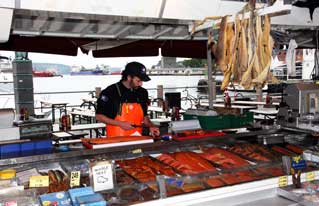 city's main harbour-side fish market, where fishing vessels
once lined the quayside with their produce filling the market stalls. These days
however in modern-day Bergen, the fishing boats are long gone. and Torget's few
remaining stalls are now manned by dubious characters ripping off the tourists
with imported fish and shell-fish at extravagantly outrageous prices. To one
side of Torget, a brash glass structure functions as the modern Fiske Torget,
selling its sterile-looking produce at even more ludicrously inflated prices. On
the upper storey we found Bergen's Tourist Information Centre whose young staff,
as in most tourist-dominated cities, were scarcely capable of handing out
brochures let alone providing useful information: the lad looked blank when
asked for the guide-leaflet to Bryggen the city's main tourist attraction! As
expected, we came away empty-handed. Downstairs in the glass-box Fiske Torget,
we wandered around the stalls marvelling not at the array of fish produce but at
the unbelievably extortionate prices being charged. Thoroughly disenchanted, we
sat outside on the empty wooden benches to eat our sandwich lunch, looking
across the murky waters of Vågen harbour to the row of Bryggen's wooden Hanseatic warehouses. city's main harbour-side fish market, where fishing vessels
once lined the quayside with their produce filling the market stalls. These days
however in modern-day Bergen, the fishing boats are long gone. and Torget's few
remaining stalls are now manned by dubious characters ripping off the tourists
with imported fish and shell-fish at extravagantly outrageous prices. To one
side of Torget, a brash glass structure functions as the modern Fiske Torget,
selling its sterile-looking produce at even more ludicrously inflated prices. On
the upper storey we found Bergen's Tourist Information Centre whose young staff,
as in most tourist-dominated cities, were scarcely capable of handing out
brochures let alone providing useful information: the lad looked blank when
asked for the guide-leaflet to Bryggen the city's main tourist attraction! As
expected, we came away empty-handed. Downstairs in the glass-box Fiske Torget,
we wandered around the stalls marvelling not at the array of fish produce but at
the unbelievably extortionate prices being charged. Thoroughly disenchanted, we
sat outside on the empty wooden benches to eat our sandwich lunch, looking
across the murky waters of Vågen harbour to the row of Bryggen's wooden Hanseatic warehouses.
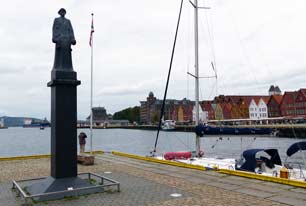 We ambled around the few remaining Torget fish
stalls which preserved something of the atmosphere that once had been the
character of the market place (see above right) (Photo
6 - Torget fishmarket). These days however only the Latin voices of Spanish and
Italian stall holders could be heard. Over on the far side Asiatic immigrants
manned stalls selling allegedly Norwegian knitwear but doubtless also Far
Eastern imports, and tacky souvenirs including the inevitable over-priced
reindeer skins; even the moose's head had attached reindeer antlers, not that
the average tourist would know the difference! Distinctly unimpressed with the
scant remains of Torget's once busy market, we wandered over to the pier to find
the
post-war statue of Leif Larsen, the Resistance hero who had led the unsuccessful human torpedo
attack on Tirpitz at Fættenfjord, and had operated the
'Shetland bus' ferrying Norwegian agents and armaments for the WW2 Resistance
(see left). We ambled around the few remaining Torget fish
stalls which preserved something of the atmosphere that once had been the
character of the market place (see above right) (Photo
6 - Torget fishmarket). These days however only the Latin voices of Spanish and
Italian stall holders could be heard. Over on the far side Asiatic immigrants
manned stalls selling allegedly Norwegian knitwear but doubtless also Far
Eastern imports, and tacky souvenirs including the inevitable over-priced
reindeer skins; even the moose's head had attached reindeer antlers, not that
the average tourist would know the difference! Distinctly unimpressed with the
scant remains of Torget's once busy market, we wandered over to the pier to find
the
post-war statue of Leif Larsen, the Resistance hero who had led the unsuccessful human torpedo
attack on Tirpitz at Fættenfjord, and had operated the
'Shetland bus' ferrying Norwegian agents and armaments for the WW2 Resistance
(see left).
The Bryggen Hanseatic warehouses:
from the pier we continued around to the much-restored Bryggen stone buildings
with their characteristic Hanseatic gables. The first of these housed the
Hanseatic Museum documenting the history of Hansa trading at Bergen; this would
have been of interest, but the high entrance price with no honnør
reductions was a persuasive disincentive. We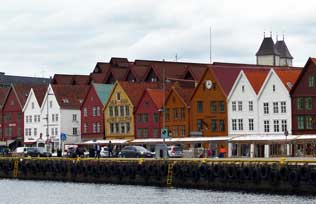 next reached the surprisingly small row of preserved, ramshackle wooden Bryggen warehouses, much beloved by
tourist literature, and now converted to a warren of tourist-oriented souvenir
shops, bars and restaurants (Photo
7 - Bryggen warehouses) (see right). At the far end of the main block of old timber
warehouses with their renowned colourful façades, we found the Bryggen Museum
which displays the archaeological finds from under the Bryggen restorations;
again this would have been worth a visit except the 80 NOK (£8) admission
price repelled. We did however a manage to obtain the Bryggen guide-leaflet (amazingly
free of charge - about the only thing in Bergen that was!) which the glitzy but
inadequate TIC was unaware of. Armed with this, we set off on our walking tour of Bryggen. next reached the surprisingly small row of preserved, ramshackle wooden Bryggen warehouses, much beloved by
tourist literature, and now converted to a warren of tourist-oriented souvenir
shops, bars and restaurants (Photo
7 - Bryggen warehouses) (see right). At the far end of the main block of old timber
warehouses with their renowned colourful façades, we found the Bryggen Museum
which displays the archaeological finds from under the Bryggen restorations;
again this would have been worth a visit except the 80 NOK (£8) admission
price repelled. We did however a manage to obtain the Bryggen guide-leaflet (amazingly
free of charge - about the only thing in Bergen that was!) which the glitzy but
inadequate TIC was unaware of. Armed with this, we set off on our walking tour of Bryggen.
We began at the rear of the warehouse complex
wandering among the narrow alleyways and passages which separated the warehouses.
Most of the current timber structures date from the 18th century, and even these
have been extensively renovated in modern times. But they still follow the
building lines of the original warehouses and merchants' dwellings, the rows of
which were separated by the carefully preserved narrow
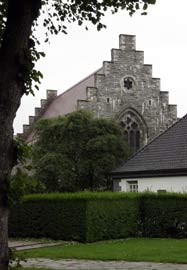 passages
(Photo
8 - Bryggen passageways). There was not a
vertical line or regular angle to be seen, with the upper structures of the
buildings leaning in higgly-piggly, every-which-way fashion. Over the
centuries, the Bryggen warehouses and residences were built on wooden piles on
reclaimed land extended out into the harbour on layer upon layer of debris and
household-waste. Archaeological digging into these layers of waste had produced
evidence of earlier occupation of the land now displayed in the Bryggen Museum.
But subsidence caused by shrinkage of the artificially raised land, hastened by
more recent drainage of the water-table by the creation of foundations for a new
hotel, had caused further subsidence and resultant tilting of the Bryggen wooden
buildings. The trading premises faced outwards onto the harbour frontage wharf,
with storage rooms and warehouses at the rear, and a hierarchical allocation of
living and eating quarters up in lofts and gabled galleries for merchants'
employees and apprentices. This tight-knit, self-regulating community of Hansa
merchants kept strict control over all its employees who were forbidden on pain
of punishment to
fraternise with local Norwegians. Our amble among the
preserved buildings gave fascinating insight into Bryggen's Hanseatic mercantile
past, the premises now serving the modern tourist industry as twee souvenir
shops and restaurants. One of the upstairs rooms however in a gallery above a
modern restaurant had been the wartime clandestine base for the Theta Resistance
group which from 1940~42 had secretly transmitted information on German naval
traffic to the Norwegian government in exile in London, until the group was
betrayed to the Gestapo. Their secret radio headquarters is now preserved as a
tiny museum to commemorate their brave wartime covert activity. passages
(Photo
8 - Bryggen passageways). There was not a
vertical line or regular angle to be seen, with the upper structures of the
buildings leaning in higgly-piggly, every-which-way fashion. Over the
centuries, the Bryggen warehouses and residences were built on wooden piles on
reclaimed land extended out into the harbour on layer upon layer of debris and
household-waste. Archaeological digging into these layers of waste had produced
evidence of earlier occupation of the land now displayed in the Bryggen Museum.
But subsidence caused by shrinkage of the artificially raised land, hastened by
more recent drainage of the water-table by the creation of foundations for a new
hotel, had caused further subsidence and resultant tilting of the Bryggen wooden
buildings. The trading premises faced outwards onto the harbour frontage wharf,
with storage rooms and warehouses at the rear, and a hierarchical allocation of
living and eating quarters up in lofts and gabled galleries for merchants'
employees and apprentices. This tight-knit, self-regulating community of Hansa
merchants kept strict control over all its employees who were forbidden on pain
of punishment to
fraternise with local Norwegians. Our amble among the
preserved buildings gave fascinating insight into Bryggen's Hanseatic mercantile
past, the premises now serving the modern tourist industry as twee souvenir
shops and restaurants. One of the upstairs rooms however in a gallery above a
modern restaurant had been the wartime clandestine base for the Theta Resistance
group which from 1940~42 had secretly transmitted information on German naval
traffic to the Norwegian government in exile in London, until the group was
betrayed to the Gestapo. Their secret radio headquarters is now preserved as a
tiny museum to commemorate their brave wartime covert activity.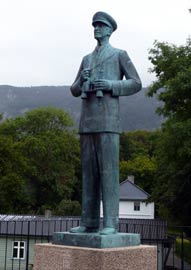
Bergenhus Festning (Fortress):
having threaded our way around the Bryggen passageways, we continued along to
the Bergenhus Festning, built in Medieval times as a fortress to protect the
harbour and later as a royal residence and political power-base. What remained
of the early fortress was wrecked in 1944 when a German munitions ship exploded
in the harbour just below the fortress walls. Two of the principal buildings
were carefully reconstructed: the Rosenkrantz Tower built as a grand fortified
residence by Erik Rosenkrantz, governor of Bergen from 1560~68, and Håkon's Hall, a reconstruction of the Gothic ceremonial hall built originally for King Håkon
Håkonsson in the mid-13th century and now used for public occasions (see above
left) (Photo
9 - Håkon's Hall). In gloomy
light, we ambled through the free access fortress gardens out to where a statue
of the King Håkon VII stood, as was his wont perhaps from his wartime exile,
gazing wistfully out along Bergen fjord to the monster cruise ships docked
in the outer harbour (see right).
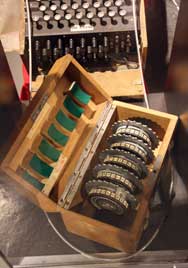 The Bergen War Museum: back past
the reconstructed Medieval buildings, we walked over to the Bergen War Museum,
selected for a visit because of its free entry. Like the equivalent museums in
Oslo and Trondheim, it documents the impact of WW2 on Bergen, with a
detailed account of the meticulously planned German invasion in May 1940 (see
left for German Enigma machine).
Further displays follow the emergence of an underground press during the
occupation and increasingly
organised resistance movement, the supply of espionage material to London on
German shipping movement, German attempts to penetrate the resistance movement
and the barbarous treatment and executions meted out by the Gestapo. Frank
coverage is given to the issue of collaboration by Norwegians both with
Quisling's Nazi movement and with the German occupiers, and finally acts of
retribution committed against collaborators after liberation in 1945, mentioning
particularly the life-long discrimination against those born to Norwegian women
by German soldiers. An interesting display detailed the Independent Norwegian
Brigade which from 1947~52 formed part of the British Army of the Rhine policing
occupied Germany after WW2, and the subsequent contribution of Norwegian armed
forces to NATO peace keeping. The Bergen War Museum: back past
the reconstructed Medieval buildings, we walked over to the Bergen War Museum,
selected for a visit because of its free entry. Like the equivalent museums in
Oslo and Trondheim, it documents the impact of WW2 on Bergen, with a
detailed account of the meticulously planned German invasion in May 1940 (see
left for German Enigma machine).
Further displays follow the emergence of an underground press during the
occupation and increasingly
organised resistance movement, the supply of espionage material to London on
German shipping movement, German attempts to penetrate the resistance movement
and the barbarous treatment and executions meted out by the Gestapo. Frank
coverage is given to the issue of collaboration by Norwegians both with
Quisling's Nazi movement and with the German occupiers, and finally acts of
retribution committed against collaborators after liberation in 1945, mentioning
particularly the life-long discrimination against those born to Norwegian women
by German soldiers. An interesting display detailed the Independent Norwegian
Brigade which from 1947~52 formed part of the British Army of the Rhine policing
occupied Germany after WW2, and the subsequent contribution of Norwegian armed
forces to NATO peace keeping.
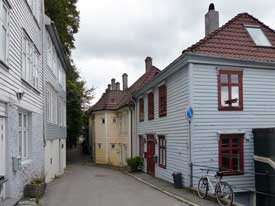 The back streets of Bergen's hill-side: we walked back past the
Mariakirken, the Renaissance-Gothic church dating from the 12th century which
from 1408~1706 had served as the church of the Hanseatic merchants.
Unfortunately extensive renovation work meant the church was totally
sealed off. But nearby we found the modern statue of the Icelandic
saga-chronicler Snorri Sturluson
whose 13th century political intrigues had brought him to Bergen. Uphill to Øvre
Gatan we left behind the tourist-dominated area of the Bryggen warehouse
complex, and along to Lille Øvre Gatan we passed the lower station of the
Fløibanen funicular railway which ascends to the heights of Fløyen mountain
above the city. Narrow stepped lanes and alleyways zigzagged steeply up the
hill-side among charactersome 19th century villas to reach a high terrace
looking down through the trees over the city roof-tops to the Korskirken church
way below (Photo
10 - Bergen hillside). From here we followed the gloomy, cobbled, narrow alley-way The back streets of Bergen's hill-side: we walked back past the
Mariakirken, the Renaissance-Gothic church dating from the 12th century which
from 1408~1706 had served as the church of the Hanseatic merchants.
Unfortunately extensive renovation work meant the church was totally
sealed off. But nearby we found the modern statue of the Icelandic
saga-chronicler Snorri Sturluson
whose 13th century political intrigues had brought him to Bergen. Uphill to Øvre
Gatan we left behind the tourist-dominated area of the Bryggen warehouse
complex, and along to Lille Øvre Gatan we passed the lower station of the
Fløibanen funicular railway which ascends to the heights of Fløyen mountain
above the city. Narrow stepped lanes and alleyways zigzagged steeply up the
hill-side among charactersome 19th century villas to reach a high terrace
looking down through the trees over the city roof-tops to the Korskirken church
way below (Photo
10 - Bergen hillside). From here we followed the gloomy, cobbled, narrow alley-way
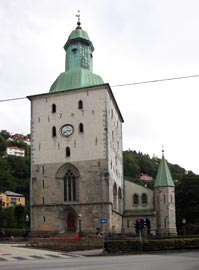 street of Bispengsgaten
(see right) which was sandwiched between the rock-face of the
hill-side and a row of terraced wooden cottages whose front doors looked out
onto the bare, dripping rock wall which was studded with bolted plates to protect against
rock-falls. This led us back downhill past the cathedral school to Bergen's 13th
century Domkirken, a squat, sturdy-looking no-nonsense edifice (see left). street of Bispengsgaten
(see right) which was sandwiched between the rock-face of the
hill-side and a row of terraced wooden cottages whose front doors looked out
onto the bare, dripping rock wall which was studded with bolted plates to protect against
rock-falls. This led us back downhill past the cathedral school to Bergen's 13th
century Domkirken, a squat, sturdy-looking no-nonsense edifice (see left).
Hurtigrute's southern terminal at Bergen harbour: back along the
quaintly named Kong Oscar gata, we began a wearying trek past the Korskirken
church to Torget, and across the modern city centre past the grey, unimpressive
National Theatre building, down towards the harbour. Having seen the Hurtigrute
express coastal liners so many times in the northern ports during our time in Norway, we
wanted to find
the company's southern home-base here in Bergen. M/S Trollfjord was at the dock-side,
having arrived back at Bergen earlier in the afternoon; we had heard her distant
horn announcing her docking at 2-30pm. Having managed to get on-board M/S
Midnattsol at Brønnøysund, we had to try the same here. Across the quayside
to the terminal and up the escalator, we asked the receptionist if we could come
aboard as port-visitors; of course, he said, and issued us with passes. Up in
the elevator to Deck 9, we took our photos from M/S Trollfjord's
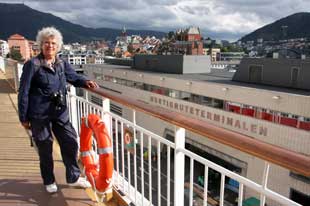 sun-deck
looking out over the Hurtigrute terminal across the city of Bergen, and for the
first time today the sun duly came out to oblige (see right)
(Photo
11 - Hurtigrute sundeck view over city). By the deck lounge-bar a large
map showed the Hurtigrute's route with its ports of call, most of which we had
visited during our time in the north (Photo
12 - Hurtigrute ports of call). The problem then was to find
our way off the ship; we had to ask twice to find the right deck for the exit,
fearing we should be trapped on-board and taken back north again. Back on dry
land, we made our way wearily back across the city centre streets to the Light
Railway terminus, and the efficient tram service transported us back out to Nestun to catch the bus from there to Bratlands Camping. We were exhausted after
our busy day in Bergen, but as a city, even allowing for the gloomy weather, it
was a disappointment: over-hyped, over-touristy, over-priced and
over-commercialised was our overwhelming impression of Norway's second-city.
That evening we turned in early as the traffic continued to thunder past. sun-deck
looking out over the Hurtigrute terminal across the city of Bergen, and for the
first time today the sun duly came out to oblige (see right)
(Photo
11 - Hurtigrute sundeck view over city). By the deck lounge-bar a large
map showed the Hurtigrute's route with its ports of call, most of which we had
visited during our time in the north (Photo
12 - Hurtigrute ports of call). The problem then was to find
our way off the ship; we had to ask twice to find the right deck for the exit,
fearing we should be trapped on-board and taken back north again. Back on dry
land, we made our way wearily back across the city centre streets to the Light
Railway terminus, and the efficient tram service transported us back out to Nestun to catch the bus from there to Bratlands Camping. We were exhausted after
our busy day in Bergen, but as a city, even allowing for the gloomy weather, it
was a disappointment: over-hyped, over-touristy, over-priced and
over-commercialised was our overwhelming impression of Norway's second-city.
That evening we turned in early as the traffic continued to thunder past.
South down the coast on E39: we woke the following morning, after a
disturbed night from the traffic noise, to a brighter sky with even the promise
of sun, but the traffic noise was more intense than ever. One of the
characteristics of an excellent campsite is your reluctance to leave; you
find reasons to dally and delay your departure. At the opposite extreme, a
feature of a third rate campsite is that you cannot wait to be on the
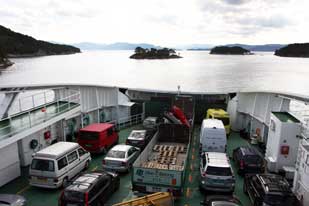 road and
away; so it was here this morning at Bratland Camping with its traffic
overwhelmed environment and dysfunctional facilities. We settled up our 2
nights' rent, retrieved our camping card, and gladly departed to face the drive
along the narrow, winding Route 580 towards Nestun where we turned off onto E39.
We had expected the E39 southwards to be semi-motorway standard, but instead it
was a narrow, winding road climbing over high ground with even a hair-pin.
Infested with heavy traffic, speed cameras and traffic cops, the road wound its
way down the peninsula's much-fretted coastline towards the busy town of Osøro
where we turned off to the ferry port of Haljem for the 40 minute crossing to
Sandvikvåg at the northern tip of the large island of Stord. E39 had been
constructed taking a curiously indeterminate route crossing from island to
peninsula by ferries and undersea tunnels along this fragmented coastline down
to Stavanger (see Maps 2 and 3 at head of page). The next stage of today's
journey would take the road along the east coast down the length of Stord island
where we had identified tonight's campsite. But first we had the ferry crossing
to reach Stord's northern tip (Photo
13 - Haljem~Sandvikvåg ferry) (see left). road and
away; so it was here this morning at Bratland Camping with its traffic
overwhelmed environment and dysfunctional facilities. We settled up our 2
nights' rent, retrieved our camping card, and gladly departed to face the drive
along the narrow, winding Route 580 towards Nestun where we turned off onto E39.
We had expected the E39 southwards to be semi-motorway standard, but instead it
was a narrow, winding road climbing over high ground with even a hair-pin.
Infested with heavy traffic, speed cameras and traffic cops, the road wound its
way down the peninsula's much-fretted coastline towards the busy town of Osøro
where we turned off to the ferry port of Haljem for the 40 minute crossing to
Sandvikvåg at the northern tip of the large island of Stord. E39 had been
constructed taking a curiously indeterminate route crossing from island to
peninsula by ferries and undersea tunnels along this fragmented coastline down
to Stavanger (see Maps 2 and 3 at head of page). The next stage of today's
journey would take the road along the east coast down the length of Stord island
where we had identified tonight's campsite. But first we had the ferry crossing
to reach Stord's northern tip (Photo
13 - Haljem~Sandvikvåg ferry) (see left).
A comical campsite with Fawlty Towers
owners: we joined the queue of vehicles at the ferry ticket-booths; fares were expensive
at 246 NOK, and with the crossing being an intrinsic part of the busy E39, the
ferry was large holding many vehicles which today included heavy trucks, buses and an
ambulance. We sat in the lounge as the ferry threaded its way between islands
heading towards the dark, hilly coast of Stord. Once ashore in now bright
sunshine, we followed E39 which shelved along the eastern coast through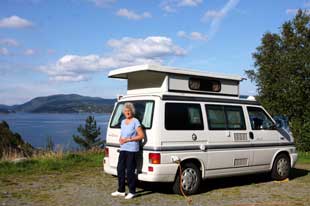 surprisingly wooded terrain above the sea. Some 12kms further brought us to the
pretentiously named Langenuen Motel and Camping. We had no great expectations of
the place; it was simply a night's stop along this SW coast road, and this final
part of the trip was proving something of an anticlimax. But the uncanny
greeting we received took the prize: leaving George at reception, we walked
around to satisfy ourselves of the campsite's acceptability, only to be accosted
by the owner in the rudest, most offensively ill-mannered tones ever
encountered, virtually accusing us of trespassing. Brushing this aside with a
duly sardonic response, we found a peaceful spot on a high terrace overlooking
the sound
(Photo
14 - Stord Island) (see right), and in spite of the owner's manner, decided to stay. Back up at
reception to book in, we now had to face his wife: this poor, sadly unfortunate
and unsmiling lady, lacking any grace or charm, greeted us with the most
comically offensive non-welcome ever experienced. They both need to be reminded
that to treat paying guests in such an
offensive manner is a certain recipe for commercial failure. Their bizarre
behaviour towards guests made Basil and Sybil Fawlty (John Cleese and
Prunella Scales) of the 1970s TV series Fawlty Towers seem acceptably
normal!
surprisingly wooded terrain above the sea. Some 12kms further brought us to the
pretentiously named Langenuen Motel and Camping. We had no great expectations of
the place; it was simply a night's stop along this SW coast road, and this final
part of the trip was proving something of an anticlimax. But the uncanny
greeting we received took the prize: leaving George at reception, we walked
around to satisfy ourselves of the campsite's acceptability, only to be accosted
by the owner in the rudest, most offensively ill-mannered tones ever
encountered, virtually accusing us of trespassing. Brushing this aside with a
duly sardonic response, we found a peaceful spot on a high terrace overlooking
the sound
(Photo
14 - Stord Island) (see right), and in spite of the owner's manner, decided to stay. Back up at
reception to book in, we now had to face his wife: this poor, sadly unfortunate
and unsmiling lady, lacking any grace or charm, greeted us with the most
comically offensive non-welcome ever experienced. They both need to be reminded
that to treat paying guests in such an
offensive manner is a certain recipe for commercial failure. Their bizarre
behaviour towards guests made Basil and Sybil Fawlty (John Cleese and
Prunella Scales) of the 1970s TV series Fawlty Towers seem acceptably
normal!
Despite the camping area's lovely outlook with
ships passing along the sound, it was impossible to find a flat pitch on the
insidiously sloping gravelled surface. Having eventually settled in, we could only laugh with wry amusement at
the campsite owners' astoundingly offensive and inhospitable behaviour; Langenuen Motel and Camping
will long be remembered, but for all the wrong reasons as one of the trip's
worst campsites.
The much-fragmented South-western coastline
and frustrating absence of campsites:
the remaining 12kms of eastern coast road brought us the following morning to
Stord's main town of Leirvik for a provisions stock-up. At the island's southern
tip, a long suspension bridge crossed to the islet of Føyno
(Photo
15 - Suspension bridge to Føyno); at the far end, the
road swung sharply to the left under the bridge's cable-stays which continued
straight ahead. Almost immediately, E39 disappeared down into the black hole of
Bømlafjord undersea tunnel (see below right)which connects
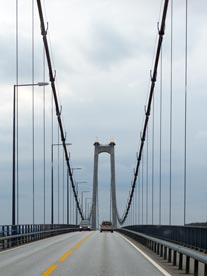 back to the much-fragmented mainland
of Sveio. 7.8kms (4.9 miles) in length and reaching a dept of 260m (854 feet)
below sea level, Bømlafjord is Norway's longest undersea tunnel, and until 2008
the world's deepest sub-sea tunnel. The tunnel was long in the planning
from 1980 as part of a triangular linkage between the islands on this coastline,
delayed by major controversy between conflicting municipalities over the exact
route, with environmentalists over pollutant impact, with ferry operators over
collection of advance tolls and with seamen's unions over job losses when the
ferries ended.
Construction finally began in 1997 and the tunnel opened in December 2000. The
heavy tolls to pay off construction costs and recompense former ferry operators
lasted until 2013, so that today we passed through toll-free. Traffic was heavy
and we were thankful for the dual lanes on each of the tunnel's 8% gradient
slopes. We emerged at the far end onto what was allegedly the mainland of Sveio
but with such a fretted coastline and so many lakes, it was difficult to
distinguish mainland from islands. The wooded, rolling hills were covered with bare
areas of scoured rock showing the glacial action that had created this uncanny
terrain which E39 now crossed. back to the much-fragmented mainland
of Sveio. 7.8kms (4.9 miles) in length and reaching a dept of 260m (854 feet)
below sea level, Bømlafjord is Norway's longest undersea tunnel, and until 2008
the world's deepest sub-sea tunnel. The tunnel was long in the planning
from 1980 as part of a triangular linkage between the islands on this coastline,
delayed by major controversy between conflicting municipalities over the exact
route, with environmentalists over pollutant impact, with ferry operators over
collection of advance tolls and with seamen's unions over job losses when the
ferries ended.
Construction finally began in 1997 and the tunnel opened in December 2000. The
heavy tolls to pay off construction costs and recompense former ferry operators
lasted until 2013, so that today we passed through toll-free. Traffic was heavy
and we were thankful for the dual lanes on each of the tunnel's 8% gradient
slopes. We emerged at the far end onto what was allegedly the mainland of Sveio
but with such a fretted coastline and so many lakes, it was difficult to
distinguish mainland from islands. The wooded, rolling hills were covered with bare
areas of scoured rock showing the glacial action that had created this uncanny
terrain which E39 now crossed.
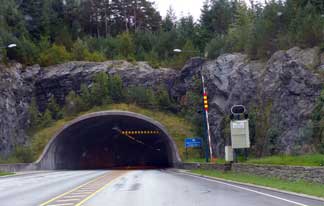 The
campsite identified for tonight was the curiously named Victor's Parking and
Boat Rental, a tiny but attractive-sounding place on the shore of Alfjord.
Signs from the main road led us for 2kms of single-track lane down to a narrow
bridge and a little marina; the campsite was closed. We decided to press on and head for
tomorrow night's campsite by the marina at Sokn 35kms further south across more
bridges linking across onto a chain of islands off the southern tip of Haugesund.
Returning to E39, traffic was now heavier as we approached the junction with
E134 coming in from Central Norway. As the southern peninsula of Sveio narrowed,
cleaved by a long fjord with the terrain showing extensive areas of bare,
glacier-scoured rock, another long bridge took E39 across to the islet of Ognøya,
with a second bridge linking across onto the further island of Austre Bokn. Here
we turned off to investigate a shore-side campsite shown on our map. Somehow
this seemed unappealing with a number of statics and the potential for road
noise, and we decided to press on for Sokn; in retrospect this was a serious mistake! The
campsite identified for tonight was the curiously named Victor's Parking and
Boat Rental, a tiny but attractive-sounding place on the shore of Alfjord.
Signs from the main road led us for 2kms of single-track lane down to a narrow
bridge and a little marina; the campsite was closed. We decided to press on and head for
tomorrow night's campsite by the marina at Sokn 35kms further south across more
bridges linking across onto a chain of islands off the southern tip of Haugesund.
Returning to E39, traffic was now heavier as we approached the junction with
E134 coming in from Central Norway. As the southern peninsula of Sveio narrowed,
cleaved by a long fjord with the terrain showing extensive areas of bare,
glacier-scoured rock, another long bridge took E39 across to the islet of Ognøya,
with a second bridge linking across onto the further island of Austre Bokn. Here
we turned off to investigate a shore-side campsite shown on our map. Somehow
this seemed unappealing with a number of statics and the potential for road
noise, and we decided to press on for Sokn; in retrospect this was a serious mistake!
A further bridge crossed onto the larger island of
Vestre Bokn, and around its eastern shore we reached the ferry-port of Arsvågen
for the 25 minute crossing to Mortavika and the next island cluster of this
road-linked archipelago
(Photo
16 - Arsvågen~Mortavika ferry). Three ferries plied back and forth across the straits
to cope with the traffic demand on this very busy main E39 as we approached
Stavanger (see below left). The fare was again expensive a 178 NOK and the ferry which arrived
almost immediately soon filled both with vehicles of all sizes and many foot
passengers including a young boy scout; this must be a very expensive area if
attending scouts involves a ferry ride. As the ferry reached the next island of Rennesøya, local
traffic was viciously competitive in their determination to be first to be let
off, a sign of the aggressively
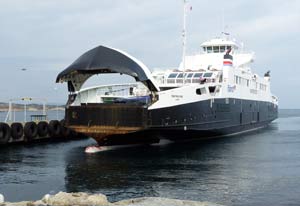 impatient driving standards to come as we
approached Stavanger. Along the length of the island, we reached another
undersea tunnel passing deep under Mastrafjord and bringing us up onto Sokn
island. Here, in the expectation of finding a quiet little water-side campsite
for the coming weekend, we turned off following signs to Sokn Marina. But no -
further frustration as we were greeted by the sight of a tiny marina-side
parking area crammed full of monster Norwegian camping cars and their rowdy
holiday-making occupants. There was just one space left, and the grumpy
custodian demanded we take it or leave it. We left it, having no intention of
staying in such alien company. impatient driving standards to come as we
approached Stavanger. Along the length of the island, we reached another
undersea tunnel passing deep under Mastrafjord and bringing us up onto Sokn
island. Here, in the expectation of finding a quiet little water-side campsite
for the coming weekend, we turned off following signs to Sokn Marina. But no -
further frustration as we were greeted by the sight of a tiny marina-side
parking area crammed full of monster Norwegian camping cars and their rowdy
holiday-making occupants. There was just one space left, and the grumpy
custodian demanded we take it or leave it. We left it, having no intention of
staying in such alien company. Weary and
in desperate frustration, we telephoned the next campsite on our list,
Vølstadskogen Camping south of Stavanger and a further ferry-crossing away; yes,
they had space for tonight, but with storms forecast for the weekend, the
response was ambiguous. We had no choice and returned to E39 where the
nose-to-tail Friday afternoon commuter traffic heading north from Stavanger
meant long delays in joining the equally busy traffic stream heading south
towards the city (Photo
17 - Heavy traffic on E39) (see below right). Having managed to join the traffic flow, we immediately passed
through an automatic toll-bomstasjon to enter a further undersea tunnel
passing under Byfjord. Traffic was virtually continuous as we descended into the
semi-darkness with furious overtaking on the steep downward slope. We re-emerged
onto the mainland peninsula just north of Stavanger, and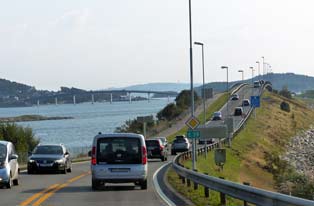 were soon passing
through semi-urban areas in intolerantly impatient traffic. Stavanger, once a
fishing town then industrialised with ship-building and now building and
servicing North sea oil and gas rigs, was clearly a high employment, high
earnings city, and as we have consistently observed, such affluent economic
circumstances are reflected in aggressively over-competitive driving standards.
And Stavanger's driving standards were the worst of all. Expecting motorway
standard road, we had to pass through the full width of the city, but in fact
E39 was normal road with frequent roundabouts. We followed signs for E39 south
and in the sickeningly vicious traffic, eventually cleared the central area of
the city and reached the urban motorway southwards. Some 10kms further, we turned off onto Route 44
near Sandes to
find Vølstadskogen Camping, obscurely tucked away but safely distant from the main
road to avoid traffic noise for the first time in several days. were soon passing
through semi-urban areas in intolerantly impatient traffic. Stavanger, once a
fishing town then industrialised with ship-building and now building and
servicing North sea oil and gas rigs, was clearly a high employment, high
earnings city, and as we have consistently observed, such affluent economic
circumstances are reflected in aggressively over-competitive driving standards.
And Stavanger's driving standards were the worst of all. Expecting motorway
standard road, we had to pass through the full width of the city, but in fact
E39 was normal road with frequent roundabouts. We followed signs for E39 south
and in the sickeningly vicious traffic, eventually cleared the central area of
the city and reached the urban motorway southwards. Some 10kms further, we turned off onto Route 44
near Sandes to
find Vølstadskogen Camping, obscurely tucked away but safely distant from the main
road to avoid traffic noise for the first time in several days.
Vølstadskogen Camping, yet another deficient
campsite: the initial greeting at reception seemed welcoming, but it
soon became apparent that things were otherwise. Prices were again cumulatively
expensive, it was another site that insisted on assigning pitch allocation, but
worst of all the facilities-building access needed a card-key for which a deposit
was charged; our request for a second key prompted an officious demand for further
deposit, and the owner showed an utterly unhelpful manner in failing to offer
any constructive response to our questions about public transport into
Stavanger. It was all just too irritatingly tedious after our long and
frustrating day. Today had supposedly been a relaxed and short run down this
seemingly interesting section of coastal road, brilliantly engineered to link an
archipelago of islands and peninsulas. In the event however, closed campsites and an
absence of acceptable alternatives had meant that 3 days travel, including a
planned rest day, had been coalesced into one; this south-western corner of
Norway was proving not only less interesting than envisaged but also more costly
in road tolls and ferry fares, with traffic levels and driving standards which were without doubt the worst experienced in the whole of Norway. It had ended up a
long and tediously frustrating day in exhausting driving conditions, and tonight
we felt utterly depressed to think we now faced almost 2 more weeks of the same
before we could escape Norway's southern corner from Langesund.
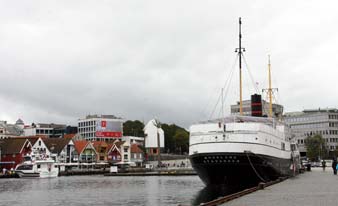 A revised plan for the trip's concluding 10
days: relaxing with a beer we took stock, and over supper the germ of
a more constructive plan began to emerge for the final days of the trip. The
forecast for Saturday was for rain storms; despite Vølstadskogen Camping's
petty restrictions and inadequacies, we could sit out the appalling wet
conditions with a day in camp here tomorrow since the ground felt firm enough to
avoid getting bogged in. Stavanger held few attractions but we could drive
into the city for a brief visit on Sunday morning when traffic would be light,
before continuing with our planned route around the far SW coastline. Rather
than spending a frustrating 10 days in Southern Norway which held even fewer
attractions, if we were to curtail our remaining time in Norway by re-scheduling our booked ferry crossing from Langesund
back to Hirtshals in Denmark, we could then spend a more constructive and
enjoyable leisurely jaunt down the west coast of Jutland, revisiting some of
places from our Danish trip in 2007, finishing at Esbjerg for our ferry
back to UK. This would give our 2014 trip a worthy conclusion and avoid it
ending on soured anticlimax. So that was decided upon. A revised plan for the trip's concluding 10
days: relaxing with a beer we took stock, and over supper the germ of
a more constructive plan began to emerge for the final days of the trip. The
forecast for Saturday was for rain storms; despite Vølstadskogen Camping's
petty restrictions and inadequacies, we could sit out the appalling wet
conditions with a day in camp here tomorrow since the ground felt firm enough to
avoid getting bogged in. Stavanger held few attractions but we could drive
into the city for a brief visit on Sunday morning when traffic would be light,
before continuing with our planned route around the far SW coastline. Rather
than spending a frustrating 10 days in Southern Norway which held even fewer
attractions, if we were to curtail our remaining time in Norway by re-scheduling our booked ferry crossing from Langesund
back to Hirtshals in Denmark, we could then spend a more constructive and
enjoyable leisurely jaunt down the west coast of Jutland, revisiting some of
places from our Danish trip in 2007, finishing at Esbjerg for our ferry
back to UK. This would give our 2014 trip a worthy conclusion and avoid it
ending on soured anticlimax. So that was decided upon.
A day in camp reveals the full extent of Vølstadskogen Camping's dysfunctional
facilities: the following morning, the forecast rain started early,
and poured all day; and did it rain! The day in camp revealed that Vølstadskogen
Camping's facilities were as frustratingly dysfunctional as the owner's attitude had been
petty, officious and unhelpful. There was, it is true, a perfectly good kitchen,
except that the wash-up sink had no hot water and the tap was broken; the owner
blamed campers for breaking it, but it had clearly been left unrepaired for
sometime. The WC/shower block was in a more remote hut, with access via
card-keys; but how often in today's pouring rain did we forget the wretched things!
The only hot water for washing up was by the loo-block, at an outside sink with
shelf too narrow for bowls! But it was the design of the WC/showers that took the prize for dysfunctionality: cubicles
were long and narrow with WC at one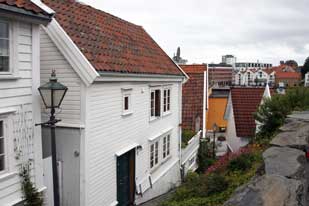 end and loo-roll out of arm's reach at far
end; the wash hand basins had a wide over-shelf so positioned to crack your
scalp when cleaning your teeth. We amused ourselves by dreaming up suitable
Mikado-like punishments to fit the architect's crime. We reluctantly paid the extra
20 NOK for internet access, and spent a satisfyingly morale-boosting day piecing
together a revised programme and researching campsites down the West Jutland
coast as a mini-holiday for the tail end of the trip. end and loo-roll out of arm's reach at far
end; the wash hand basins had a wide over-shelf so positioned to crack your
scalp when cleaning your teeth. We amused ourselves by dreaming up suitable
Mikado-like punishments to fit the architect's crime. We reluctantly paid the extra
20 NOK for internet access, and spent a satisfyingly morale-boosting day piecing
together a revised programme and researching campsites down the West Jutland
coast as a mini-holiday for the tail end of the trip.
A brief visit to Stavanger:
the hopelessly inadequate Vølstadskogen Camping was yet another of SW Norway's
campsites that we were eager to get away from, and morale lifted further when we
drove through the gate of the wretched place the following morning. Re-joining the
E39 urban motorway, we returned the 10kms north towards Stavanger, thankful that
on a Sunday morning there was little traffic. Our sat-nav guided us through
urban byways with reassuring precision into the city centre to park by the
quay-side of the Vågen harbour a short distance from the main square of Torget
(see above left).
Stavanger's 19th century economy was built on the herring fishing industry, and
when the herring began to fail, shipping and ship-building took over. Since the
oil and gas boom of the 1970~80s, rig construction and servicing have become the
mainstay of Stavanger's thriving economy, resulting in high employment and
affluence, reflected in the arrogant and aggressive driving standards around the city.
Today's visit was going to be a fleeting one, and thankfully on a Sunday
morning, the town was quiet and traffic light.
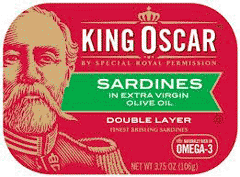 The
Sardine Canning Museum in Stavanger: the most attractive part of what was, after
wartime German bombing, a mainly modern city was the area of 19th century wooden
cottages built originally to provide housing for ship workers and those employed
in processing and canning herrings caught around Stavanger
(see above right) (Photo
18 - Herring canning workers' cottages at Stavanger). A number of herring
processing factories flourished here providing employment for 100s of locals and
enriching the herring merchants. One of these sardine smoke-houses and canning
factories survives as the Norske Hermetikk Museum (Canning
Museum), which describes the processing and canning of locally caught sprats
from the 1830s until the last canneries closed in 1983. We walked along the
harbour-front and up the cobbled lanes into the attractive area of trim, white
clap-boarded cottages with their rose gardens; what had once been workers'
housing was now a select area of twee residences. Here in the midst of the
wooden cottages, we found the
Sardine Canning Museum, and on the first Sunday of the month, which by lucky
chance today was,
sprats are still smoked to demonstrate the old industry; they were truly
delicious. The museum preserves all the machinery used in the processing and
canning of sprats, starting with The
Sardine Canning Museum in Stavanger: the most attractive part of what was, after
wartime German bombing, a mainly modern city was the area of 19th century wooden
cottages built originally to provide housing for ship workers and those employed
in processing and canning herrings caught around Stavanger
(see above right) (Photo
18 - Herring canning workers' cottages at Stavanger). A number of herring
processing factories flourished here providing employment for 100s of locals and
enriching the herring merchants. One of these sardine smoke-houses and canning
factories survives as the Norske Hermetikk Museum (Canning
Museum), which describes the processing and canning of locally caught sprats
from the 1830s until the last canneries closed in 1983. We walked along the
harbour-front and up the cobbled lanes into the attractive area of trim, white
clap-boarded cottages with their rose gardens; what had once been workers'
housing was now a select area of twee residences. Here in the midst of the
wooden cottages, we found the
Sardine Canning Museum, and on the first Sunday of the month, which by lucky
chance today was,
sprats are still smoked to demonstrate the old industry; they were truly
delicious. The museum preserves all the machinery used in the processing and
canning of sprats, starting with producing the flat cans with their familiar
wire-key, which usually broke half-way through opening the tin. We leant
that sardines were not a distinct species of fish, but a generic term for any
fish of the herring family including pilchards and sprats (Brisling in
Norwegian) which were canned here in Stavanger. The fish catch was starved for 3
days to clear them out, then salted and threaded onto rods to be hung in
smoking ovens for up to an hour
(Photo
19 - Sardine smoking oven); oak smoking gave Stavanger sprats their
characteristic taste. The heads were removed by machine and the sprats sorted
and layered in tins by hand (Photo
20 - Hand canning sprats), before the cans were sealed, sterilised and labels
added ready for packing. The factories used a variety of exotic labels including
the famous King Oscar Brand (see left) which all during our trip we had enjoyed
in our lunch sandwiches; King Oscar sardines are still caught off Stavanger but
these days are processed and canned in Poland. The labels became a popular
collectors' item, one of the most popular being Skipper brand (see right) with the face of a
bearded Scottish seafarer William Anderson; the unwelcome celebrity status which
this brought made the poor man unemployable by ship owners, but so grateful was
the canning factory for the publicity he brought them that he was put on their
payroll for the rest of his life. Remember the name for your next pub quiz night!
producing the flat cans with their familiar
wire-key, which usually broke half-way through opening the tin. We leant
that sardines were not a distinct species of fish, but a generic term for any
fish of the herring family including pilchards and sprats (Brisling in
Norwegian) which were canned here in Stavanger. The fish catch was starved for 3
days to clear them out, then salted and threaded onto rods to be hung in
smoking ovens for up to an hour
(Photo
19 - Sardine smoking oven); oak smoking gave Stavanger sprats their
characteristic taste. The heads were removed by machine and the sprats sorted
and layered in tins by hand (Photo
20 - Hand canning sprats), before the cans were sealed, sterilised and labels
added ready for packing. The factories used a variety of exotic labels including
the famous King Oscar Brand (see left) which all during our trip we had enjoyed
in our lunch sandwiches; King Oscar sardines are still caught off Stavanger but
these days are processed and canned in Poland. The labels became a popular
collectors' item, one of the most popular being Skipper brand (see right) with the face of a
bearded Scottish seafarer William Anderson; the unwelcome celebrity status which
this brought made the poor man unemployable by ship owners, but so grateful was
the canning factory for the publicity he brought them that he was put on their
payroll for the rest of his life. Remember the name for your next pub quiz night!
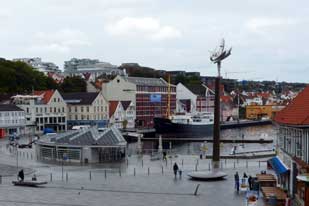 From the cobbled lanes among the old wooden
cottages with the smell of oak-smoke from the canning factory on the air, we
returned to the harbour-front and sought shelter from the rain in the Maritime
Museum. Set in an old wooden warehouse, the museum's displays document the
development of Stavanger's flourishing shipping and ship-building industries,
and more recently rig-building and bulk transportation of crude oil and gas from
the North Sea production fields to refineries world-wide. From the cobbled lanes among the old wooden
cottages with the smell of oak-smoke from the canning factory on the air, we
returned to the harbour-front and sought shelter from the rain in the Maritime
Museum. Set in an old wooden warehouse, the museum's displays document the
development of Stavanger's flourishing shipping and ship-building industries,
and more recently rig-building and bulk transportation of crude oil and gas from
the North Sea production fields to refineries world-wide.
Stavanger Cathedral: with the light
now very dull, we walked around to the head of the harbour and up through Torget
(see left)
(Photo
21 - Stavanger Torget)
to Stavanger's Domkirke, founded in the early 12th century and dedicated to St
Swithun; the Cathedral's first bishop came from Winchester and brought with him to
Stavanger a holy relic, the saint's left arm! The Cathedral's exterior was shrouded
in covering for stonework renovation, but unexpectedly the door was open. The
interior was truly magnificent with sturdy Romanesque columns and rounded arches
lining the nave. In the late 12th century the Cathedral was extended with the
addition of a Gothic chancel, a stark contrast in architectural style from the
nave. The Baroque period added extravagant decorations including an outrageously
ornate carved wooden pulpit incorporating biblical scenes and supported by a
sporting figure of Samson
(Photo
22 - Stavanger Cathedral) (see below right). Our brief but selective time in Stavanger was running
out, and we returned to George down at the harbour to extricate ourselves from
the city centre to re-join the E39 motorway south.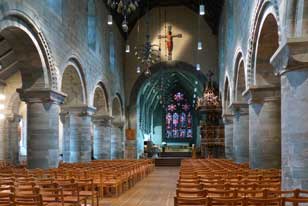
The south-west coast road down to Egersund:
we turned off onto Route 44 heading SW towards the coast, passing through
uncharacteristically flat farming country with not a hill in sight, and the
land criss-crossed by sturdy dry-stone walls. Reaching the coast, the road ran
parallel with the sea which sparkled in the afternoon sunshine. Beyond the
village of Ogna, the flat countryside changed suddenly and dramatically to hilly
terrain, the narrow road climbing and winding between rocky outcrops. In heavier
traffic driving standards again became unpleasantly aggressive; it was as
if in our final days in the country, Norwegians were truly trying to reinforce
their image as an arrogant people lacking in manners. The road continued over craggy
high ground and descended steeply to the outskirts of the small industrial town
of Egersund.
Steinsnes Camping, Egersund:
here we found Steinsnes Camping. Despite the gruff greeting from the woman at
reception, the campsite seemed pleasant enough with camping areas and huts set
in rows along the banks of a fast-flowing salmon river whose roaring served
to mask out the traffic noise (see left). The following morning, we telephoned Fjordline
Ferries: there was no problem in bringing forward our ferry booking for the
crossing
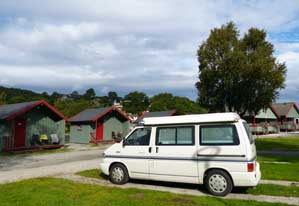 from Langesund to Hirtshals. The original fare had been at the bargain
price of €42, but with a €77 penalty to change the booking, it was cheaper to
book afresh at €55. Such was our eagerness for an early release from Norway, we
had no option but to pay up! Steinsnes Camping is run by NAF, the Norwegian
equivalent of the AA/RAC; and despite their usually high prices, here at Egersund the
nightly charge was a very reasonable all-inclusive 225 NOK including unlimited
showers and wi-fi. In total contrast with Vølstadskogen Camping, facilities here
at Steinsnes Camping were some of the best experienced in the whole of Norway: 8
integrated and large-sized bathrooms (shower, WC and wash hand basin), each
thoughtfully laid out and clearly designed by someone who had either used
campsite facilities or showed a ready understanding of campers' needs. There
were plenty of hooks for clothing and wash-bag, an additional hook within easy
reach of the large shower cubicle for your towel, and a stool to sit on while
drying your feet. The wash hand basin had a good sized shelf but positioned to
one side to avoid bumping your head when cleaning your teeth; and ultra luxury -
decent toilet paper and soft paper hand towels. All spotlessly clean with
unlimited hot water, these facilities were a delight to use. All of this may
seem self evident, but if you have ever used campsite facilities, you will know
only too well how infrequently they are to the standard of design and
cleanliness you would expect in your own home. Steinsnes NAF Camping at Egersund
wins full marks for the homely excellence of its facilities. from Langesund to Hirtshals. The original fare had been at the bargain
price of €42, but with a €77 penalty to change the booking, it was cheaper to
book afresh at €55. Such was our eagerness for an early release from Norway, we
had no option but to pay up! Steinsnes Camping is run by NAF, the Norwegian
equivalent of the AA/RAC; and despite their usually high prices, here at Egersund the
nightly charge was a very reasonable all-inclusive 225 NOK including unlimited
showers and wi-fi. In total contrast with Vølstadskogen Camping, facilities here
at Steinsnes Camping were some of the best experienced in the whole of Norway: 8
integrated and large-sized bathrooms (shower, WC and wash hand basin), each
thoughtfully laid out and clearly designed by someone who had either used
campsite facilities or showed a ready understanding of campers' needs. There
were plenty of hooks for clothing and wash-bag, an additional hook within easy
reach of the large shower cubicle for your towel, and a stool to sit on while
drying your feet. The wash hand basin had a good sized shelf but positioned to
one side to avoid bumping your head when cleaning your teeth; and ultra luxury -
decent toilet paper and soft paper hand towels. All spotlessly clean with
unlimited hot water, these facilities were a delight to use. All of this may
seem self evident, but if you have ever used campsite facilities, you will know
only too well how infrequently they are to the standard of design and
cleanliness you would expect in your own home. Steinsnes NAF Camping at Egersund
wins full marks for the homely excellence of its facilities.
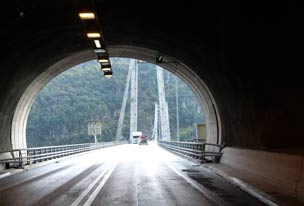 Lindenes lighthouse, Norway's southernmost
point: leaving Egersund,
we headed up into the hills to re-join the main E39 which gained further height
into increasingly rugged countryside. This was more like fjord country with long
lakes filling valleys lined with high craggy hills. Beyond the small town of Moi,
the terrain became even more wild with the road running through a succession of
short tunnels alongside the huge lake of Lundevatnet. After a further even more
spectacular series of tunnels, one with a spur road branching off within the
tunnel, the road emerged from the far tunnel mouth directly onto a
suspension bridge across Fedafjord, immediately to enter a another tunnel mouth
on the far side directly into the mountainside, truly impressive engineering
(see right).
The road lost height through further tunnels down to the town of Lyngdal close
to the south coast. Just beyond here we turned off onto Route 460 for the final 20km drive
out to Lindenes and its Fyr (lighthouse), Norway's southernmost point. The
narrow lane Lindenes lighthouse, Norway's southernmost
point: leaving Egersund,
we headed up into the hills to re-join the main E39 which gained further height
into increasingly rugged countryside. This was more like fjord country with long
lakes filling valleys lined with high craggy hills. Beyond the small town of Moi,
the terrain became even more wild with the road running through a succession of
short tunnels alongside the huge lake of Lundevatnet. After a further even more
spectacular series of tunnels, one with a spur road branching off within the
tunnel, the road emerged from the far tunnel mouth directly onto a
suspension bridge across Fedafjord, immediately to enter a another tunnel mouth
on the far side directly into the mountainside, truly impressive engineering
(see right).
The road lost height through further tunnels down to the town of Lyngdal close
to the south coast. Just beyond here we turned off onto Route 460 for the final 20km drive
out to Lindenes and its Fyr (lighthouse), Norway's southernmost point. The
narrow lane
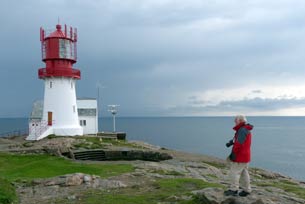 wound around the much-indented southern coastline eventually
reaching Lindenes Fyr. There was a summer admission charge of 50 NOK to the
lighthouse site, but with the visitor centre now closed in mid-September, we
were able to walk straight in. The first lighthouse to mark this exposed point,
a coal-fired beacon, was lit in 1656. The current lighthouse tower built in 1915
has halogen lamps. The natural area around the fyr and former lighthouse-keepers'
houses was beautifully landscaped, and we spent time clambering over the rocks
and taking photo from the southernmost point (see left) (Photo
23 - Lindenes Lighthouse). Back at the car park, the sign
pointed north reading Nordkapp 2,518kms, Slettnes Fyr (the northernmost point of
the Norwegian mainland) 2,814kms. We had now travelled fully from the bottom to
the top of Norway and back again! And after today's gloomy rain, the sun now
came out to celebrate
(Photo
24 - Norway's southernmost point) (see below right). wound around the much-indented southern coastline eventually
reaching Lindenes Fyr. There was a summer admission charge of 50 NOK to the
lighthouse site, but with the visitor centre now closed in mid-September, we
were able to walk straight in. The first lighthouse to mark this exposed point,
a coal-fired beacon, was lit in 1656. The current lighthouse tower built in 1915
has halogen lamps. The natural area around the fyr and former lighthouse-keepers'
houses was beautifully landscaped, and we spent time clambering over the rocks
and taking photo from the southernmost point (see left) (Photo
23 - Lindenes Lighthouse). Back at the car park, the sign
pointed north reading Nordkapp 2,518kms, Slettnes Fyr (the northernmost point of
the Norwegian mainland) 2,814kms. We had now travelled fully from the bottom to
the top of Norway and back again! And after today's gloomy rain, the sun now
came out to celebrate
(Photo
24 - Norway's southernmost point) (see below right).
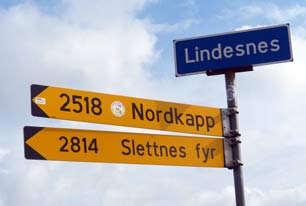 Lindenes Camping: a couple of kms back along the lane from the
lighthouse, we turned into Lindenes Camping. This was an expensive site with mediocre facilities, but the
owner was welcoming and the setting clustered along an inlet from the southern
coast near the tiny marina of Lille Havn was delightful; the small and low-lying
camping area was wet after recent rains but we selected a gravelled pitch and
settled in at what was our penultimate campsite in Norway. We were up early the
following morning for today's long drive back to Langesund; after a flaring
dawn (see below left), our pitch was in perfect alignment to sit for breakfast with the sun from
over the sea streaming in through the camper's sliding door. Lindenes Camping: a couple of kms back along the lane from the
lighthouse, we turned into Lindenes Camping. This was an expensive site with mediocre facilities, but the
owner was welcoming and the setting clustered along an inlet from the southern
coast near the tiny marina of Lille Havn was delightful; the small and low-lying
camping area was wet after recent rains but we selected a gravelled pitch and
settled in at what was our penultimate campsite in Norway. We were up early the
following morning for today's long drive back to Langesund; after a flaring
dawn (see below left), our pitch was in perfect alignment to sit for breakfast with the sun from
over the sea streaming in through the camper's sliding door.
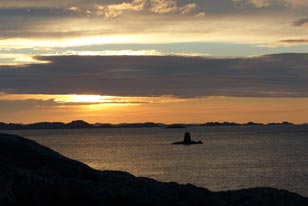 The southern Norwegian coastal city of Kristiansand: returning the
20kms along the winding coastal lane, we re-joined the main E39 and turned
eastwards through less rugged, wooded countryside past Mandal. Progress was slow
until the approach to Kristiansand where we headed in towards the city centre on
urban motorways, eventually managing to work our way through to the main street
and park at Vestre Strandgata near to the docks. Norway's 5th largest city with
80,000 inhabitants was founded originally in 1641 by the Danish 'Builder King'
Christian IV who had also established many similar towns around his Danish
realms which at that time included Norway, and Skåne in SW Sweden. His
foundations were generally named eponymously after the King, such as Kristianstad in Skåne, the rebuilt
city of Kristiana (Oslo), and Kristiansand here in
Southern Norway. Like his other projects, Kristiansand was built to a regular
grid-plan which it retains today. Christian IV's intention was to strengthen his
kingdom's coastal defences on the northern side of the Skagerrak particularly
against the Swedes, by arming the new town with a fortress which The southern Norwegian coastal city of Kristiansand: returning the
20kms along the winding coastal lane, we re-joined the main E39 and turned
eastwards through less rugged, wooded countryside past Mandal. Progress was slow
until the approach to Kristiansand where we headed in towards the city centre on
urban motorways, eventually managing to work our way through to the main street
and park at Vestre Strandgata near to the docks. Norway's 5th largest city with
80,000 inhabitants was founded originally in 1641 by the Danish 'Builder King'
Christian IV who had also established many similar towns around his Danish
realms which at that time included Norway, and Skåne in SW Sweden. His
foundations were generally named eponymously after the King, such as Kristianstad in Skåne, the rebuilt
city of Kristiana (Oslo), and Kristiansand here in
Southern Norway. Like his other projects, Kristiansand was built to a regular
grid-plan which it retains today. Christian IV's intention was to strengthen his
kingdom's coastal defences on the northern side of the Skagerrak particularly
against the Swedes, by arming the new town with a fortress which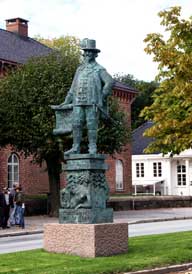 remains today.
In 1941 the German occupiers did similar, building a coastal battery equipped
with enormous naval guns close to Kristiansand, and opposite a similar
emplacement at Hanstholm on the North Jutland coast to guard the Skagerrak
against Allied attack and deny access to the Baltic. remains today.
In 1941 the German occupiers did similar, building a coastal battery equipped
with enormous naval guns close to Kristiansand, and opposite a similar
emplacement at Hanstholm on the North Jutland coast to guard the Skagerrak
against Allied attack and deny access to the Baltic.
We set off for our brief visit to Kristiansand,
walking along Vestre Strandgata to the Fiske Brygge, a tiny indoor fish market
and shadow of what once must have been a sizeable market at such an important
fishing port. Across the street through the gardens of Strand-promenaden and
past the marina, we reached the remains of Christian IV's Christianholm Festning
(Fortress) (Photo
25 - Christian IV's fortress at Kristiansand). Built between 1662~72 on an island connected to the town by a bridge
over a deep moat where ships once moored but filled in during the 19th century,
its function was to protect the Skagerrak straits. In fact the only time it ever
saw action was in 1807 when it resisted an attack by a squadron of Nelson's
warships. Its star-shaped, 5 feet thick earth and stone ramparts enclose a
central squat, sturdy circular tower. We were able to walk through into the
fortress grounds, its few rather sad-looking canons now guarding the marina. But
the tower, now topped with a modern conical roof, was all locked up.
Back over to the town, we walked along
Festningsgata, passing an unflattering statue of Kristiansand's founding king
(see right), to find the wooden houses of the Posebyen old town. The central
area of Kristiansand retains the exact grid pattern (kvadraturen)
of the town's 17th century foundation, with the NW quadrant still having a
number of attractive 19th century wooden clap-boarded houses (see below left). The modern city has
spread out across nearby islands and coast, but the old town around the port
retains
Christian IV's original founding layout backing onto the fortress. We crossed
Kongens gate and Dronningens gate (King and Queen's Street) and turned along
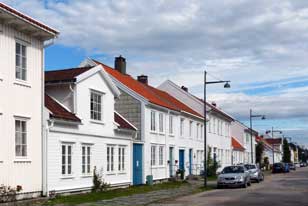 Holbergs
gate, photographing the attractive white and ochre painted clap board faced
wooden houses of the old town (Photo
26- Posebyen wooden cottages); the name Posebyen is said to be derived
from the nickname given by French soldiers stationed here on shore leave during
the Napoleonic Wars, from the French verb reposer, to rest. Returning
through the modern part of the quadrant grid of streets, we passed the
unnoteworthy 19th century Gothic Domkirke where yet another unmistakably
anorexic statue of King Håkon VII stood, gazing this time at the Rådhus (town
hall). Our visit to Kristiansand had inevitably been brief, and the time on our
parking ticket was running out. We returned down to the harbour-side car park to
extricate ourselves from the tangle of streets and return to E39 to resume our
eastward journey. Holbergs
gate, photographing the attractive white and ochre painted clap board faced
wooden houses of the old town (Photo
26- Posebyen wooden cottages); the name Posebyen is said to be derived
from the nickname given by French soldiers stationed here on shore leave during
the Napoleonic Wars, from the French verb reposer, to rest. Returning
through the modern part of the quadrant grid of streets, we passed the
unnoteworthy 19th century Gothic Domkirke where yet another unmistakably
anorexic statue of King Håkon VII stood, gazing this time at the Rådhus (town
hall). Our visit to Kristiansand had inevitably been brief, and the time on our
parking ticket was running out. We returned down to the harbour-side car park to
extricate ourselves from the tangle of streets and return to E39 to resume our
eastward journey.
A dreary drive along the south coast back to
Langesund:
after crossing 2 fjord-mouths on suspension bridges on the outskirts of
Kristiansand, the E18 towards Oslo was now motorway standard and the 90kph speed
limit enabled us to make good progress. For the first 40 kms, the road was high
standard with well-lit tunnels, as we passed a string of south coast resorts,
but at Arendal the motorway ended. E18 became single-carriage road with cameras
enforcing the 70/80 kph speed limit, but no passing lane for the insistently
speeding traffic. The sky had now darkened and rain began adding to the
unpleasant driving conditions. Despite the 80 kph speed limit and speed cameras,
speeding heavy trucks harassing from behind in wet conditions made this a
stressful drive. Beyond Kragerø and a final stretch of single-carriageway, we
were at last able to turn off onto Route 352 leading down into Langesund.
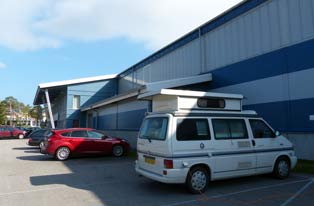
Skjærgårds-hallen Sports Centre camping-aire at
Langesund: there
had once been a campsite in the hills nearby, but we knew this had closed; a
telephone call to Langesund TIC had helpfully given us details of a camping-aire
by the sports centre in the port-village which would serve as an overnight stop
before tomorrow's ferry. We followed the lane down towards the ferry port, and
found the Skjærgårds-hallen Sports Centre; sure enough in one corner of the car
park a row of spaces had been reserved for campers and fully equipped with
electric sockets (see right). An overnight stay cost just 150 NOK with WC/showers in the sports
centre available 08-30~20-30 while the hall was open; there were 2 integrated
bathrooms with showers and WC reserved for campers and spotlessly clean. This was an ideal solution and we went inside to book in. The sports centre
receptionist was helpfully welcoming and showed us around, and we were soon
settled in to one of the camping spaces with the sun now brightly shining,
looking forward to escaping to Denmark by ferry tomorrow for our end-of-trip
mini-holiday in Jutland.
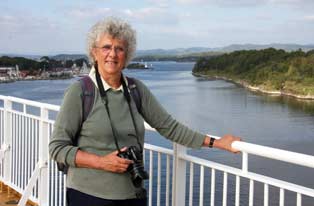 Departing Norway by ferry from Langesund:
on our final morning, we were woken by clients much in need of the sports
centre's facilities to relieve their gross obesity arriving early. We had no
time pressures today with nothing to do but final shopping at the local Co-op
before going down to the ferry dock for the 15-00 sailing across the Skagerrak to Hirtshals in North Jutland. Accordingly, now in holiday mood, we took a relaxed
morning. We had expected limited facilities, but when it came to showers, the
sports centre bathrooms provided some of the most homely facilities experienced
the whole trip; we wallowed in utter luxury enjoying the unlimited hot water
without wretched coin-meters ticking away. Norwegian campsite owners take note!
The morning disappeared, and it was almost 12-30pm by the time we were packed
and drove along through the village to the Co-op for our concluding take-home
Norwegian shopping. At 1-30pm we finally drove down to the ferry port and booked
in without difficulty simply quoting the new booking reference number given over
the phone. There were a surprising number of vehicles already queuing,
camping-cars galore and lines of heavy trucks, but few cars. The Fjordline ferry from Hirtshals drew into the dock, and soon after 2-00pm boarding began. Departing Norway by ferry from Langesund:
on our final morning, we were woken by clients much in need of the sports
centre's facilities to relieve their gross obesity arriving early. We had no
time pressures today with nothing to do but final shopping at the local Co-op
before going down to the ferry dock for the 15-00 sailing across the Skagerrak to Hirtshals in North Jutland. Accordingly, now in holiday mood, we took a relaxed
morning. We had expected limited facilities, but when it came to showers, the
sports centre bathrooms provided some of the most homely facilities experienced
the whole trip; we wallowed in utter luxury enjoying the unlimited hot water
without wretched coin-meters ticking away. Norwegian campsite owners take note!
The morning disappeared, and it was almost 12-30pm by the time we were packed
and drove along through the village to the Co-op for our concluding take-home
Norwegian shopping. At 1-30pm we finally drove down to the ferry port and booked
in without difficulty simply quoting the new booking reference number given over
the phone. There were a surprising number of vehicles already queuing,
camping-cars galore and lines of heavy trucks, but few cars. The Fjordline ferry from Hirtshals drew into the dock, and soon after 2-00pm boarding began.
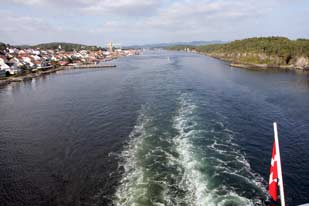 We had
during our time in Norway used so many small ferries that this one now seemed
huge; despite the number of vehicles, there was still plenty of space on the car
deck. We went immediately up onto the sun-deck for our photos departing Norway
as the ferry edged away from the dock (Photo
27- Departing Langesund), turned and steamed down the narrow
channel past the village and tiny port of Langesund, and out into the Skagerrak
to begin the crossing (Photo
28 - Farewell Norway). The sun was bright with little wind, and we hoped
for a smooth crossing of these notorious straits as when we came out in early
May . We had
during our time in Norway used so many small ferries that this one now seemed
huge; despite the number of vehicles, there was still plenty of space on the car
deck. We went immediately up onto the sun-deck for our photos departing Norway
as the ferry edged away from the dock (Photo
27- Departing Langesund), turned and steamed down the narrow
channel past the village and tiny port of Langesund, and out into the Skagerrak
to begin the crossing (Photo
28 - Farewell Norway). The sun was bright with little wind, and we hoped
for a smooth crossing of these notorious straits as when we came out in early
May .
Our feelings about Norway after living there
for 5 months: it has to be said that, almost uniquely during our many
years of travelling, this was the first time we were not sorry to be leaving what
had been for the last 5 months our host country. Our final week in Norway had
been frustrating and disappointing, but our disillusionment with Norwegians,
particularly in the South went back further than this. There is no doubt that
the spectacular topography and scenic beauty of Norway is unsurpassed, and the
country's transport infrastructure of bridges, tunnels and ferries is eminently
impressive, enabling ready (if at times expensive) travelling through the
extremes of such mountainous topography and fragmented coastline. So why were we
so disenchanted with Norway? The explanation rests with a society degenerated by
over-affluence. With the 1970s windfall discovery of North Sea oil and gas, the
Norwegian economy suddenly boomed, transforming what had been one of Europe's
poorest countries into one of the richest. Oil and gas wealth has transformed
the Norwegian economy and today Norwegians enjoy the second-highest European GDP
per-capita (after Luxembourg) and fourth-highest in the world. It
is true that Norway's oil-rich national economy has made possible the opening up
of the country with its challenging topography, with the mass tourism industry
adding further to the national economy, even if blighting the lives of people in
small communities as we had seen over the last few weeks. It feels that Norway
is now a country with a distinct north~south divide. In the Arctic north,
although tourism and oil and gas wealth benefits coastal towns like Hammerfest,
life for most people is still tough particularly in rural areas, and the same
hard-working, dour character which Paul recalls from the pre-oil wealth days of
1968 is still seen. In contrast in the south however this same affluence
resulting from the North Sea oil and gas boom, and consequent high employment
and the personal wealth that this has brought for some, has regrettably also
produced other unwelcome and unsavoury changes to the Norwegian people's life
style and behaviour. A Finnish couple we spoke with made an interesting observation about
Norwegians, or at least those living in the south of the country: they described
them as a once impoverished nation who had happened upon their oil and gas
bonanza purely by chance in the 1970s, not by hard-won effort. Their sudden and
unearned chance acquisition of oil wealth had brought national and personal
affluence; but they now behave just like lottery winners who, lacking the grace
and good taste to use their newly won affluence wisely, lavishly squander it on
tastelessly overt, extreme materialism. This perhaps accounts for the mega-bus
camping-cars and monster caravans befouling every lay-by along E6 and the
ubiquitous, grossly exhibitionist 4WDs. It also correlates with Norwegians'
pompously arrogant behaviour, lack of manners and absence of awareness for
others which we found so offensive, and the intolerantly aggressive, harrowing
driving standards we had experienced. In summary, contemporary Norwegian
society, particularly in the south of the country, felt for us so alien; it
reminded us too much of what we find so objectionable with life in contemporary
UK, and why along with many others of our generation we spend so much time away
from our home country.
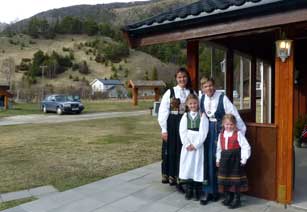 Having said that, we certainly have no regrets about the time we spent during
summer 2014
in Norway; while the cost of living was expensive and the driving at times
taxing, the photographic potential was unrivalled, and the learning was
inestimable. We also have treasured memories of many individual Norwegians we
met during our travels, who thankfully represent a more worthy image of
modern Norway which we prefer to recall than the general impression outlined
above, and who deserve to be mentioned by name: Having said that, we certainly have no regrets about the time we spent during
summer 2014
in Norway; while the cost of living was expensive and the driving at times
taxing, the photographic potential was unrivalled, and the learning was
inestimable. We also have treasured memories of many individual Norwegians we
met during our travels, who thankfully represent a more worthy image of
modern Norway which we prefer to recall than the general impression outlined
above, and who deserve to be mentioned by name:
- Peder and Oliver, the Storting
officials who gave time to give us a personalised tour of the Norwegian
Parliament in Oslo
- Anne-Ma Hoelsbrekken and her family (see
right) who
made us so welcome at Bjørkhol Camping in Gudbrandsdal valley, Norway's
friendliest and most hospitable campsite
- the hard-working Petrita, long time owner
of Jotunheimen Feriesenter
- Eva the delightful
caretaker at Vikhammer Camping Trondheim, originally from Szeged in
Hungary, who spoke several European languages including fluent English; a
lovely lady with a warm personality who took such pride in her work in
keeping the facilities spotlessly clean, and in helping the campsite guests;
she really was an asset to the campsite and we hope the owner duly
appreciates that
- Astrid and her Mum at Josterdal Camping,
Gjerde which is kept by this charming lady; along with Bjørkhol,
Josterdal Camping is without doubt the finest campsite in the
whole of Norway, and if you don't believe us look at what others say on
Josterdal Camping's Guestbook
- the owners of many other exceptionally
hospitable campsites we stayed at, mentioning particularly Elverum
Camping, Fagernes Camping, Nyheim Camping on the E6 in Nord Trøndelag,
Ness Camping at Skutvik, Brustranda Camping Vestvågøya in
Lofotens, Sildpollnes Sjø-camping Austvågøya, Oppmyre Camping Langøya, Midnattsol Camping Andøya, Ramfjord Camping Sørbotn, Berlevåg Pensonjat
and Camping, Vestre Jakobselv Camping Vadsø,
Elvegård Camping Saltstraumen, Mjelva Camping Åndalsnes, Stadheimfossen
Camping Hellesylt, Grande Camping Oppstryn, Bøyum Camping Fjærland
- the lady in the Esso garage north of Oslo
who, in fluent English, explained the mysteries of Autopass road-toll
payments
- Svein Krogud who took time to give us a
personalised tour of the locomotive collection at the Norwegian National
Railway Museum at a time when oficially it was closed
- the people of Oppdal who shared with us
their 2014 National Day festival parade at Dovrefjell
- Lars Smestadmoen, verger at Ringebu stave
church who explained to us the intricacies of traditional stave construction techniques
- the staff of the VW garages at Mosjøen and Tromsø, who with
impressive efficiency, secured a replacement wing-mirror glass for George,
even allowing for right-hand drive
- the delightfully helpful staff at Fagenes
and Sortland (Langøya, Vesterålen) Tourist Information Centres, the best
TICs in Norway
- Steinar Larsen, curator of the Stockfish
Museum at Å i Lofoten, polyglot and enthusiast par excellence on all there
is to know about production and export of Lofoten Stockfish
- although not Norwegian, Claudine and Alain
Boulard from Avignon in France, whom we met at Bodø Cathedral and again on
the crossing of Reinefjord to Vindstad
- the young lass whom we met in Kabelvåg,
Austvågøya as she got off the bus, who told us so proudly of her fruit and
vegetable packing work
- the residents of the isolated but
self-sufficient communities
of Kjøllefjord and Berlevåg on the Barents Sea coast, and of Fjærland valley
and Undredal in Southern Norway
- the gasman of Sortland (Langøya,
Vesterålen) who checked the level of our partly-used gas cylinder and
confirmed our regulator's suitability for propane, and the gasman of
Steinkjer who re-filled our now empty cylinder with propane
- Jerry Webb, English cyclist/canoeist and
like-minded traveller whom we met at Oppmyre Camping (Langøya, Vesterålen)
and at Nyksund
- the Finnish couple from Rovaniemi whom we
met on the Lyngenfjord ferry and who shared with us their incisive and
insightful observations
on contemporary Norwegian society
- Willy and Nelly Simonsen, the former
owners of ANSI-Turistservice Camping at Storeng, met 2 years ago when we
travelled south on E6 from Finmark; we wish them both a long and happy
retirement
- Ludevic Besnard, fish exporter at
Berlevåg and originally from Rennes in
Brittany; we thank him for his gift of Berlevåg haddock, and wish his business well
- the ladies in the Co-op at Kautokeino who
sell the best lingonberry jam in Norway
- the lads of the Vilhelmina Harley Davidson
Motor Cycle Club, whom we met on the Tjøtta~Forvik ferry and who told us of
the Torghatten 'hole-in-the-mountain' walk
- the young guide at Kvernes stave church
who with demure modesty attributed her fluent English to having had a good
teacher
- the lady-owner of the Tusand og Ei Natt (1001 Nights) second-hand bookshop in Mundal
founded in 1995, from whom we bought souvenir books from Fjærland's Booktown;
we wish her another 20 years of trading
To all these delightful people, we send our best wishes
and thanks for the privilege of meeting them; they have all endeared themselves
to us and we treasure the memories.
Our experience in 2012~13 in the neighbouring Scandinavian
countries of Finland and Sweden highlighted the contrast with the general run of contemporary
Norwegian society that we observed in 2014 and have summarised above. While the Swedes cannily
managed to steer clear of the horrors which Germany inflicted on the rest of
Europe in WW2, and still enjoy the resultant affluence and high standards of
living, their society also still retains a civility which the Norwegians
generally have lost
with their chance acquisition of wealth. Finland suffered hideously from Russian
barbarism in WW2 but achieved a hard-won post-war recovery, pulling itself up by
effort and hard work, and also still retains a civilised society. In contrast with
our 2014 experience in Norway, we found society and behavioural standards in
both Sweden and Finland so much more congenial. For this reason our 2015 travels
will take us back to Finland, and doubtless in 2016 we shall return to Sweden.
But before our 2015 travel can begin, we shall conclude this year's series of
travelogues with our customary review of the 82 campsites we used during our
travels through Norway.
Final edition
reviewing campsites in Norway to be published shortly
|
Sheila and Paul |
Published: 17 March 2015 |
|
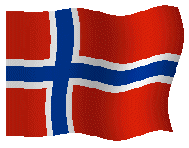
 CAMPING
IN NORWAY 2014 - Port-city of Bergen, south-western coastal road, ferries and undersea tunnels
to Stavanger, Norway's southernmost point, Kristiansand, south coast to Langesund
for ferry back to Denmark:
CAMPING
IN NORWAY 2014 - Port-city of Bergen, south-western coastal road, ferries and undersea tunnels
to Stavanger, Norway's southernmost point, Kristiansand, south coast to Langesund
for ferry back to Denmark: Stalheim and its view down into Nærøydalen:
leaving Vang Camping in the murky depths of Nærøydalen, we drove up this
magnificent valley with its high mountain side-walls still partly
obscured by cloud (
Stalheim and its view down into Nærøydalen:
leaving Vang Camping in the murky depths of Nærøydalen, we drove up this
magnificent valley with its high mountain side-walls still partly
obscured by cloud ( Because tour-buses regularly, and totally
improbably, negotiate this single-track, winding road down the 18% hair-pins, the
old route is now restricted to one-way down only. Paul must have travelled this
way pre-tunnels in 1968 on the service bus from Voss for the ferry down Nærøyfjord from Gudvangen to Kaupanger, though he has only limited recollections
of journey and its startling views. Today in our camper we took the modern road
up through the tunnels (see above left),
with E16 curving round at a steep gradient (but certainly not 18%!), to emerge
just before the turning into the upper section of the Stalheimskleiva. We turned
into this
single-track lane which climbed for 2kms to reach the modern Stalheim Hotel where
Paul's bus in 1968 must have stopped before descending the Stalheimskleiva
hair-pins. Through binoculars we could just make out today the precipitous path
up to the Husmannsplassen Nåli mountain farm high on the mountainside above the
sheer drop down into Nærøydalen. The farm had been occupied until 1930, and its
approach path now serves as a severe walking route, but not for vertigo
sufferers! The hotel staff responded with graceful courtesy to our hesitant
enquiry about access to the terrace overlooking Nærøydalen: yes of course, they
said, and the view from the wall of the terrace garden, perched on the edge of
the high shelf was beyond description (
Because tour-buses regularly, and totally
improbably, negotiate this single-track, winding road down the 18% hair-pins, the
old route is now restricted to one-way down only. Paul must have travelled this
way pre-tunnels in 1968 on the service bus from Voss for the ferry down Nærøyfjord from Gudvangen to Kaupanger, though he has only limited recollections
of journey and its startling views. Today in our camper we took the modern road
up through the tunnels (see above left),
with E16 curving round at a steep gradient (but certainly not 18%!), to emerge
just before the turning into the upper section of the Stalheimskleiva. We turned
into this
single-track lane which climbed for 2kms to reach the modern Stalheim Hotel where
Paul's bus in 1968 must have stopped before descending the Stalheimskleiva
hair-pins. Through binoculars we could just make out today the precipitous path
up to the Husmannsplassen Nåli mountain farm high on the mountainside above the
sheer drop down into Nærøydalen. The farm had been occupied until 1930, and its
approach path now serves as a severe walking route, but not for vertigo
sufferers! The hotel staff responded with graceful courtesy to our hesitant
enquiry about access to the terrace overlooking Nærøydalen: yes of course, they
said, and the view from the wall of the terrace garden, perched on the edge of
the high shelf was beyond description ( downwards
via the hair-pins? Common sense, or at least our interpretation of it, said
otherwise, and we carefully returned the way we had come up, back to re-join E16 westwards.
downwards
via the hair-pins? Common sense, or at least our interpretation of it, said
otherwise, and we carefully returned the way we had come up, back to re-join E16 westwards. Bratland Camping, the closest campsite to
Bergen: the E16 road and
railway line ran in parallel along a rocky valley above river and lakes, passing
through an amazing total of 22 tunnels of between 500m and 2kms in length (see
above right) (
Bratland Camping, the closest campsite to
Bergen: the E16 road and
railway line ran in parallel along a rocky valley above river and lakes, passing
through an amazing total of 22 tunnels of between 500m and 2kms in length (see
above right) ( with due courtesy and help with city street plan and public transport details. The
difficulty then was to find a viable pitch: the campsite was divided into
several small gravelled camping areas, but the least unattractive was inevitably
closest to the main road and traffic noise. A lot of effort had been put into
creating bays in each area, but the bays were unduly restricted in size even for
a small camper like George, with risk of catching doors
on the raised side-walls (see left). But even worse was the absence of a level surface; we
tried all the areas without success, eventually settling down by the road as the
least unsatisfactory despite the traffic noise. On top of all of this, Bratland's
facilities were ill-designed and dysfunctional; it was a hopeless site. We took
stock: despite having allowed 2 days for visiting Bergen, it was an unappealing
city with over-expensive museums; this and the traffic-ridden campsite meant we should confine our time in
Bergen to just one day.
with due courtesy and help with city street plan and public transport details. The
difficulty then was to find a viable pitch: the campsite was divided into
several small gravelled camping areas, but the least unattractive was inevitably
closest to the main road and traffic noise. A lot of effort had been put into
creating bays in each area, but the bays were unduly restricted in size even for
a small camper like George, with risk of catching doors
on the raised side-walls (see left). But even worse was the absence of a level surface; we
tried all the areas without success, eventually settling down by the road as the
least unsatisfactory despite the traffic noise. On top of all of this, Bratland's
facilities were ill-designed and dysfunctional; it was a hopeless site. We took
stock: despite having allowed 2 days for visiting Bergen, it was an unappealing
city with over-expensive museums; this and the traffic-ridden campsite meant we should confine our time in
Bergen to just one day. Bergen's history: Bergen was founded in 1070 by King Olaf Kyrre
(the Peaceful), son of Harald Hardråde and survivor of the 1066 Battle of
Stanford Bridge, and became the most important of Medieval Norway's towns and
the royal residence. In the 13th century, the mercantile city joined the
Hanseatic Trading League. German merchants settled here, setting up their first
office in Bergen in 1360 and transforming the wharf-side Bryggen into one of the
League's 4 major headquarters abroad. For some 400 years Bryggen was ruled by
this tight-knit community of some 2,000 German resident traders who imported
grain and food-stuffs and exported dried fish. German economic strength
dominated the region, reducing local interests to a state of dependency. By then
the Norwegian seat of royal authority had moved to Oslo, and was more than
content to gather the easily collected tax revenues from the Hansa guild of
German merchants, even compelling west-coast fishermen to sell their catch to
the merchants at prices dictated by the merchants themselves. By the 15th
century, competition from Dutch and English shipping companies began the
Hanseatic League's decline, but even in the 17/18th centuries Bergen was still
the trading hub of Scandinavia with Bergen remaining an important maritime
trading centre until the Hanseatic League's Bergen office finally closed in
1899. German and later Norwegian mercantile trading interests had flourished at
Bergen as a self-regulating trading station, enriching its merchants at the
expense of local fishermen. Today Bryggen still flourishes but now as the
centre-piece of Bergen's mass tourism industry, with cruise ships lining the
quays of the outer Vågen harbour beyond the remains of the Bergenhus Festning
(Fortress) which once dominated the port.
Bergen's history: Bergen was founded in 1070 by King Olaf Kyrre
(the Peaceful), son of Harald Hardråde and survivor of the 1066 Battle of
Stanford Bridge, and became the most important of Medieval Norway's towns and
the royal residence. In the 13th century, the mercantile city joined the
Hanseatic Trading League. German merchants settled here, setting up their first
office in Bergen in 1360 and transforming the wharf-side Bryggen into one of the
League's 4 major headquarters abroad. For some 400 years Bryggen was ruled by
this tight-knit community of some 2,000 German resident traders who imported
grain and food-stuffs and exported dried fish. German economic strength
dominated the region, reducing local interests to a state of dependency. By then
the Norwegian seat of royal authority had moved to Oslo, and was more than
content to gather the easily collected tax revenues from the Hansa guild of
German merchants, even compelling west-coast fishermen to sell their catch to
the merchants at prices dictated by the merchants themselves. By the 15th
century, competition from Dutch and English shipping companies began the
Hanseatic League's decline, but even in the 17/18th centuries Bergen was still
the trading hub of Scandinavia with Bergen remaining an important maritime
trading centre until the Hanseatic League's Bergen office finally closed in
1899. German and later Norwegian mercantile trading interests had flourished at
Bergen as a self-regulating trading station, enriching its merchants at the
expense of local fishermen. Today Bryggen still flourishes but now as the
centre-piece of Bergen's mass tourism industry, with cruise ships lining the
quays of the outer Vågen harbour beyond the remains of the Bergenhus Festning
(Fortress) which once dominated the port. city's main harbour-side fish market, where fishing vessels
once lined the quayside with their produce filling the market stalls. These days
however in modern-day Bergen, the fishing boats are long gone. and Torget's few
remaining stalls are now manned by dubious characters ripping off the tourists
with imported fish and shell-fish at extravagantly outrageous prices. To one
side of Torget, a brash glass structure functions as the modern Fiske Torget,
selling its sterile-looking produce at even more ludicrously inflated prices. On
the upper storey we found Bergen's Tourist Information Centre whose young staff,
as in most tourist-dominated cities, were scarcely capable of handing out
brochures let alone providing useful information: the lad looked blank when
asked for the guide-leaflet to Bryggen the city's main tourist attraction! As
expected, we came away empty-handed. Downstairs in the glass-box Fiske Torget,
we wandered around the stalls marvelling not at the array of fish produce but at
the unbelievably extortionate prices being charged. Thoroughly disenchanted, we
sat outside on the empty wooden benches to eat our sandwich lunch, looking
across the murky waters of Vågen harbour to the row of Bryggen's wooden Hanseatic warehouses.
city's main harbour-side fish market, where fishing vessels
once lined the quayside with their produce filling the market stalls. These days
however in modern-day Bergen, the fishing boats are long gone. and Torget's few
remaining stalls are now manned by dubious characters ripping off the tourists
with imported fish and shell-fish at extravagantly outrageous prices. To one
side of Torget, a brash glass structure functions as the modern Fiske Torget,
selling its sterile-looking produce at even more ludicrously inflated prices. On
the upper storey we found Bergen's Tourist Information Centre whose young staff,
as in most tourist-dominated cities, were scarcely capable of handing out
brochures let alone providing useful information: the lad looked blank when
asked for the guide-leaflet to Bryggen the city's main tourist attraction! As
expected, we came away empty-handed. Downstairs in the glass-box Fiske Torget,
we wandered around the stalls marvelling not at the array of fish produce but at
the unbelievably extortionate prices being charged. Thoroughly disenchanted, we
sat outside on the empty wooden benches to eat our sandwich lunch, looking
across the murky waters of Vågen harbour to the row of Bryggen's wooden Hanseatic warehouses. We ambled around the few remaining Torget fish
stalls which preserved something of the atmosphere that once had been the
character of the market place (see above right) (
We ambled around the few remaining Torget fish
stalls which preserved something of the atmosphere that once had been the
character of the market place (see above right) ( next reached the surprisingly small row of preserved, ramshackle wooden Bryggen warehouses, much beloved by
tourist literature, and now converted to a warren of tourist-oriented souvenir
shops, bars and restaurants (
next reached the surprisingly small row of preserved, ramshackle wooden Bryggen warehouses, much beloved by
tourist literature, and now converted to a warren of tourist-oriented souvenir
shops, bars and restaurants ( passages
(
passages
(
 The Bergen War Museum: back past
the reconstructed Medieval buildings, we walked over to the Bergen War Museum,
selected for a visit because of its free entry. Like the equivalent museums in
Oslo and Trondheim, it documents the impact of WW2 on Bergen, with a
detailed account of the meticulously planned German invasion in May 1940 (see
left for German Enigma machine).
Further displays follow the emergence of an underground press during the
occupation and increasingly
organised resistance movement, the supply of espionage material to London on
German shipping movement, German attempts to penetrate the resistance movement
and the barbarous treatment and executions meted out by the Gestapo. Frank
coverage is given to the issue of collaboration by Norwegians both with
Quisling's Nazi movement and with the German occupiers, and finally acts of
retribution committed against collaborators after liberation in 1945, mentioning
particularly the life-long discrimination against those born to Norwegian women
by German soldiers. An interesting display detailed the Independent Norwegian
Brigade which from 1947~52 formed part of the British Army of the Rhine policing
occupied Germany after WW2, and the subsequent contribution of Norwegian armed
forces to NATO peace keeping.
The Bergen War Museum: back past
the reconstructed Medieval buildings, we walked over to the Bergen War Museum,
selected for a visit because of its free entry. Like the equivalent museums in
Oslo and Trondheim, it documents the impact of WW2 on Bergen, with a
detailed account of the meticulously planned German invasion in May 1940 (see
left for German Enigma machine).
Further displays follow the emergence of an underground press during the
occupation and increasingly
organised resistance movement, the supply of espionage material to London on
German shipping movement, German attempts to penetrate the resistance movement
and the barbarous treatment and executions meted out by the Gestapo. Frank
coverage is given to the issue of collaboration by Norwegians both with
Quisling's Nazi movement and with the German occupiers, and finally acts of
retribution committed against collaborators after liberation in 1945, mentioning
particularly the life-long discrimination against those born to Norwegian women
by German soldiers. An interesting display detailed the Independent Norwegian
Brigade which from 1947~52 formed part of the British Army of the Rhine policing
occupied Germany after WW2, and the subsequent contribution of Norwegian armed
forces to NATO peace keeping. The back streets of Bergen's hill-side: we walked back past the
Mariakirken, the Renaissance-Gothic church dating from the 12th century which
from 1408~1706 had served as the church of the Hanseatic merchants.
Unfortunately extensive renovation work meant the church was totally
sealed off. But nearby we found the modern statue of the Icelandic
saga-chronicler Snorri Sturluson
whose 13th century political intrigues had brought him to Bergen. Uphill to Øvre
Gatan we left behind the tourist-dominated area of the Bryggen warehouse
complex, and along to Lille Øvre Gatan we passed the lower station of the
Fløibanen funicular railway which ascends to the heights of Fløyen mountain
above the city. Narrow stepped lanes and alleyways zigzagged steeply up the
hill-side among charactersome 19th century villas to reach a high terrace
looking down through the trees over the city roof-tops to the Korskirken church
way below (
The back streets of Bergen's hill-side: we walked back past the
Mariakirken, the Renaissance-Gothic church dating from the 12th century which
from 1408~1706 had served as the church of the Hanseatic merchants.
Unfortunately extensive renovation work meant the church was totally
sealed off. But nearby we found the modern statue of the Icelandic
saga-chronicler Snorri Sturluson
whose 13th century political intrigues had brought him to Bergen. Uphill to Øvre
Gatan we left behind the tourist-dominated area of the Bryggen warehouse
complex, and along to Lille Øvre Gatan we passed the lower station of the
Fløibanen funicular railway which ascends to the heights of Fløyen mountain
above the city. Narrow stepped lanes and alleyways zigzagged steeply up the
hill-side among charactersome 19th century villas to reach a high terrace
looking down through the trees over the city roof-tops to the Korskirken church
way below ( street of Bispengsgaten
(see right) which was sandwiched between the rock-face of the
hill-side and a row of terraced wooden cottages whose front doors looked out
onto the bare, dripping rock wall which was studded with bolted plates to protect against
rock-falls. This led us back downhill past the cathedral school to Bergen's 13th
century Domkirken, a squat, sturdy-looking no-nonsense edifice (see left).
street of Bispengsgaten
(see right) which was sandwiched between the rock-face of the
hill-side and a row of terraced wooden cottages whose front doors looked out
onto the bare, dripping rock wall which was studded with bolted plates to protect against
rock-falls. This led us back downhill past the cathedral school to Bergen's 13th
century Domkirken, a squat, sturdy-looking no-nonsense edifice (see left). sun-deck
looking out over the Hurtigrute terminal across the city of Bergen, and for the
first time today the sun duly came out to oblige (see right)
(
sun-deck
looking out over the Hurtigrute terminal across the city of Bergen, and for the
first time today the sun duly came out to oblige (see right)
( road and
away; so it was here this morning at Bratland Camping with its traffic
overwhelmed environment and dysfunctional facilities. We settled up our 2
nights' rent, retrieved our camping card, and gladly departed to face the drive
along the narrow, winding Route 580 towards Nestun where we turned off onto E39.
We had expected the E39 southwards to be semi-motorway standard, but instead it
was a narrow, winding road climbing over high ground with even a hair-pin.
Infested with heavy traffic, speed cameras and traffic cops, the road wound its
way down the peninsula's much-fretted coastline towards the busy town of Osøro
where we turned off to the ferry port of Haljem for the 40 minute crossing to
Sandvikvåg at the northern tip of the large island of Stord. E39 had been
constructed taking a curiously indeterminate route crossing from island to
peninsula by ferries and undersea tunnels along this fragmented coastline down
to Stavanger (see Maps 2 and 3 at head of page). The next stage of today's
journey would take the road along the east coast down the length of Stord island
where we had identified tonight's campsite. But first we had the ferry crossing
to reach Stord's northern tip (
road and
away; so it was here this morning at Bratland Camping with its traffic
overwhelmed environment and dysfunctional facilities. We settled up our 2
nights' rent, retrieved our camping card, and gladly departed to face the drive
along the narrow, winding Route 580 towards Nestun where we turned off onto E39.
We had expected the E39 southwards to be semi-motorway standard, but instead it
was a narrow, winding road climbing over high ground with even a hair-pin.
Infested with heavy traffic, speed cameras and traffic cops, the road wound its
way down the peninsula's much-fretted coastline towards the busy town of Osøro
where we turned off to the ferry port of Haljem for the 40 minute crossing to
Sandvikvåg at the northern tip of the large island of Stord. E39 had been
constructed taking a curiously indeterminate route crossing from island to
peninsula by ferries and undersea tunnels along this fragmented coastline down
to Stavanger (see Maps 2 and 3 at head of page). The next stage of today's
journey would take the road along the east coast down the length of Stord island
where we had identified tonight's campsite. But first we had the ferry crossing
to reach Stord's northern tip ( surprisingly wooded terrain above the sea. Some 12kms further brought us to the
pretentiously named Langenuen Motel and Camping. We had no great expectations of
the place; it was simply a night's stop along this SW coast road, and this final
part of the trip was proving something of an anticlimax. But the uncanny
greeting we received took the prize: leaving George at reception, we walked
around to satisfy ourselves of the campsite's acceptability, only to be accosted
by the owner in the rudest, most offensively ill-mannered tones ever
encountered, virtually accusing us of trespassing. Brushing this aside with a
duly sardonic response, we found a peaceful spot on a high terrace overlooking
the sound
(
surprisingly wooded terrain above the sea. Some 12kms further brought us to the
pretentiously named Langenuen Motel and Camping. We had no great expectations of
the place; it was simply a night's stop along this SW coast road, and this final
part of the trip was proving something of an anticlimax. But the uncanny
greeting we received took the prize: leaving George at reception, we walked
around to satisfy ourselves of the campsite's acceptability, only to be accosted
by the owner in the rudest, most offensively ill-mannered tones ever
encountered, virtually accusing us of trespassing. Brushing this aside with a
duly sardonic response, we found a peaceful spot on a high terrace overlooking
the sound
( back to the much-fragmented mainland
of Sveio. 7.8kms (4.9 miles) in length and reaching a dept of 260m (854 feet)
below sea level, Bømlafjord is Norway's longest undersea tunnel, and until 2008
the world's deepest sub-sea tunnel. The tunnel was long in the planning
from 1980 as part of a triangular linkage between the islands on this coastline,
delayed by major controversy between conflicting municipalities over the exact
route, with environmentalists over pollutant impact, with ferry operators over
collection of advance tolls and with seamen's unions over job losses when the
ferries ended.
Construction finally began in 1997 and the tunnel opened in December 2000. The
heavy tolls to pay off construction costs and recompense former ferry operators
lasted until 2013, so that today we passed through toll-free. Traffic was heavy
and we were thankful for the dual lanes on each of the tunnel's 8% gradient
slopes. We emerged at the far end onto what was allegedly the mainland of Sveio
but with such a fretted coastline and so many lakes, it was difficult to
distinguish mainland from islands. The wooded, rolling hills were covered with bare
areas of scoured rock showing the glacial action that had created this uncanny
terrain which E39 now crossed.
back to the much-fragmented mainland
of Sveio. 7.8kms (4.9 miles) in length and reaching a dept of 260m (854 feet)
below sea level, Bømlafjord is Norway's longest undersea tunnel, and until 2008
the world's deepest sub-sea tunnel. The tunnel was long in the planning
from 1980 as part of a triangular linkage between the islands on this coastline,
delayed by major controversy between conflicting municipalities over the exact
route, with environmentalists over pollutant impact, with ferry operators over
collection of advance tolls and with seamen's unions over job losses when the
ferries ended.
Construction finally began in 1997 and the tunnel opened in December 2000. The
heavy tolls to pay off construction costs and recompense former ferry operators
lasted until 2013, so that today we passed through toll-free. Traffic was heavy
and we were thankful for the dual lanes on each of the tunnel's 8% gradient
slopes. We emerged at the far end onto what was allegedly the mainland of Sveio
but with such a fretted coastline and so many lakes, it was difficult to
distinguish mainland from islands. The wooded, rolling hills were covered with bare
areas of scoured rock showing the glacial action that had created this uncanny
terrain which E39 now crossed. The
campsite identified for tonight was the curiously named Victor's Parking and
Boat Rental, a tiny but attractive-sounding place on the shore of Alfjord.
Signs from the main road led us for 2kms of single-track lane down to a narrow
bridge and a little marina; the campsite was closed. We decided to press on and head for
tomorrow night's campsite by the marina at Sokn 35kms further south across more
bridges linking across onto a chain of islands off the southern tip of Haugesund.
Returning to E39, traffic was now heavier as we approached the junction with
E134 coming in from Central Norway. As the southern peninsula of Sveio narrowed,
cleaved by a long fjord with the terrain showing extensive areas of bare,
glacier-scoured rock, another long bridge took E39 across to the islet of Ognøya,
with a second bridge linking across onto the further island of Austre Bokn. Here
we turned off to investigate a shore-side campsite shown on our map. Somehow
this seemed unappealing with a number of statics and the potential for road
noise, and we decided to press on for Sokn; in retrospect this was a serious mistake!
The
campsite identified for tonight was the curiously named Victor's Parking and
Boat Rental, a tiny but attractive-sounding place on the shore of Alfjord.
Signs from the main road led us for 2kms of single-track lane down to a narrow
bridge and a little marina; the campsite was closed. We decided to press on and head for
tomorrow night's campsite by the marina at Sokn 35kms further south across more
bridges linking across onto a chain of islands off the southern tip of Haugesund.
Returning to E39, traffic was now heavier as we approached the junction with
E134 coming in from Central Norway. As the southern peninsula of Sveio narrowed,
cleaved by a long fjord with the terrain showing extensive areas of bare,
glacier-scoured rock, another long bridge took E39 across to the islet of Ognøya,
with a second bridge linking across onto the further island of Austre Bokn. Here
we turned off to investigate a shore-side campsite shown on our map. Somehow
this seemed unappealing with a number of statics and the potential for road
noise, and we decided to press on for Sokn; in retrospect this was a serious mistake! impatient driving standards to come as we
approached Stavanger. Along the length of the island, we reached another
undersea tunnel passing deep under Mastrafjord and bringing us up onto Sokn
island. Here, in the expectation of finding a quiet little water-side campsite
for the coming weekend, we turned off following signs to Sokn Marina. But no -
further frustration as we were greeted by the sight of a tiny marina-side
parking area crammed full of monster Norwegian camping cars and their rowdy
holiday-making occupants. There was just one space left, and the grumpy
custodian demanded we take it or leave it. We left it, having no intention of
staying in such alien company.
impatient driving standards to come as we
approached Stavanger. Along the length of the island, we reached another
undersea tunnel passing deep under Mastrafjord and bringing us up onto Sokn
island. Here, in the expectation of finding a quiet little water-side campsite
for the coming weekend, we turned off following signs to Sokn Marina. But no -
further frustration as we were greeted by the sight of a tiny marina-side
parking area crammed full of monster Norwegian camping cars and their rowdy
holiday-making occupants. There was just one space left, and the grumpy
custodian demanded we take it or leave it. We left it, having no intention of
staying in such alien company. were soon passing
through semi-urban areas in intolerantly impatient traffic. Stavanger, once a
fishing town then industrialised with ship-building and now building and
servicing North sea oil and gas rigs, was clearly a high employment, high
earnings city, and as we have consistently observed, such affluent economic
circumstances are reflected in aggressively over-competitive driving standards.
And Stavanger's driving standards were the worst of all. Expecting motorway
standard road, we had to pass through the full width of the city, but in fact
E39 was normal road with frequent roundabouts. We followed signs for E39 south
and in the sickeningly vicious traffic, eventually cleared the central area of
the city and reached the urban motorway southwards. Some 10kms further, we turned off onto Route 44
near Sandes to
find Vølstadskogen Camping, obscurely tucked away but safely distant from the main
road to avoid traffic noise for the first time in several days.
were soon passing
through semi-urban areas in intolerantly impatient traffic. Stavanger, once a
fishing town then industrialised with ship-building and now building and
servicing North sea oil and gas rigs, was clearly a high employment, high
earnings city, and as we have consistently observed, such affluent economic
circumstances are reflected in aggressively over-competitive driving standards.
And Stavanger's driving standards were the worst of all. Expecting motorway
standard road, we had to pass through the full width of the city, but in fact
E39 was normal road with frequent roundabouts. We followed signs for E39 south
and in the sickeningly vicious traffic, eventually cleared the central area of
the city and reached the urban motorway southwards. Some 10kms further, we turned off onto Route 44
near Sandes to
find Vølstadskogen Camping, obscurely tucked away but safely distant from the main
road to avoid traffic noise for the first time in several days. A revised plan for the trip's concluding 10
days: relaxing with a beer we took stock, and over supper the germ of
a more constructive plan began to emerge for the final days of the trip. The
forecast for Saturday was for rain storms; despite Vølstadskogen Camping's
petty restrictions and inadequacies, we could sit out the appalling wet
conditions with a day in camp here tomorrow since the ground felt firm enough to
avoid getting bogged in. Stavanger held few attractions but we could drive
into the city for a brief visit on Sunday morning when traffic would be light,
before continuing with our planned route around the far SW coastline. Rather
than spending a frustrating 10 days in Southern Norway which held even fewer
attractions, if we were to curtail our remaining time in Norway by re-scheduling our booked ferry crossing from Langesund
back to Hirtshals in Denmark, we could then spend a more constructive and
enjoyable leisurely jaunt down the west coast of Jutland, revisiting some of
places from our Danish trip in 2007, finishing at Esbjerg for our ferry
back to UK. This would give our 2014 trip a worthy conclusion and avoid it
ending on soured anticlimax. So that was decided upon.
A revised plan for the trip's concluding 10
days: relaxing with a beer we took stock, and over supper the germ of
a more constructive plan began to emerge for the final days of the trip. The
forecast for Saturday was for rain storms; despite Vølstadskogen Camping's
petty restrictions and inadequacies, we could sit out the appalling wet
conditions with a day in camp here tomorrow since the ground felt firm enough to
avoid getting bogged in. Stavanger held few attractions but we could drive
into the city for a brief visit on Sunday morning when traffic would be light,
before continuing with our planned route around the far SW coastline. Rather
than spending a frustrating 10 days in Southern Norway which held even fewer
attractions, if we were to curtail our remaining time in Norway by re-scheduling our booked ferry crossing from Langesund
back to Hirtshals in Denmark, we could then spend a more constructive and
enjoyable leisurely jaunt down the west coast of Jutland, revisiting some of
places from our Danish trip in 2007, finishing at Esbjerg for our ferry
back to UK. This would give our 2014 trip a worthy conclusion and avoid it
ending on soured anticlimax. So that was decided upon. end and loo-roll out of arm's reach at far
end; the wash hand basins had a wide over-shelf so positioned to crack your
scalp when cleaning your teeth. We amused ourselves by dreaming up suitable
Mikado-like punishments to fit the architect's crime. We reluctantly paid the extra
20 NOK for internet access, and spent a satisfyingly morale-boosting day piecing
together a revised programme and researching campsites down the West Jutland
coast as a mini-holiday for the tail end of the trip.
end and loo-roll out of arm's reach at far
end; the wash hand basins had a wide over-shelf so positioned to crack your
scalp when cleaning your teeth. We amused ourselves by dreaming up suitable
Mikado-like punishments to fit the architect's crime. We reluctantly paid the extra
20 NOK for internet access, and spent a satisfyingly morale-boosting day piecing
together a revised programme and researching campsites down the West Jutland
coast as a mini-holiday for the tail end of the trip. The
Sardine Canning Museum in Stavanger: the most attractive part of what was, after
wartime German bombing, a mainly modern city was the area of 19th century wooden
cottages built originally to provide housing for ship workers and those employed
in processing and canning herrings caught around Stavanger
(see above right) (
The
Sardine Canning Museum in Stavanger: the most attractive part of what was, after
wartime German bombing, a mainly modern city was the area of 19th century wooden
cottages built originally to provide housing for ship workers and those employed
in processing and canning herrings caught around Stavanger
(see above right) ( producing the flat cans with their familiar
wire-key, which usually broke half-way through opening the tin. We leant
that sardines were not a distinct species of fish, but a generic term for any
fish of the herring family including pilchards and sprats (Brisling in
Norwegian) which were canned here in Stavanger. The fish catch was starved for 3
days to clear them out, then salted and threaded onto rods to be hung in
smoking ovens for up to an hour
(
producing the flat cans with their familiar
wire-key, which usually broke half-way through opening the tin. We leant
that sardines were not a distinct species of fish, but a generic term for any
fish of the herring family including pilchards and sprats (Brisling in
Norwegian) which were canned here in Stavanger. The fish catch was starved for 3
days to clear them out, then salted and threaded onto rods to be hung in
smoking ovens for up to an hour
( From the cobbled lanes among the old wooden
cottages with the smell of oak-smoke from the canning factory on the air, we
returned to the harbour-front and sought shelter from the rain in the Maritime
Museum. Set in an old wooden warehouse, the museum's displays document the
development of Stavanger's flourishing shipping and ship-building industries,
and more recently rig-building and bulk transportation of crude oil and gas from
the North Sea production fields to refineries world-wide.
From the cobbled lanes among the old wooden
cottages with the smell of oak-smoke from the canning factory on the air, we
returned to the harbour-front and sought shelter from the rain in the Maritime
Museum. Set in an old wooden warehouse, the museum's displays document the
development of Stavanger's flourishing shipping and ship-building industries,
and more recently rig-building and bulk transportation of crude oil and gas from
the North Sea production fields to refineries world-wide.
 from Langesund to Hirtshals. The original fare had been at the bargain
price of €42, but with a €77 penalty to change the booking, it was cheaper to
book afresh at €55. Such was our eagerness for an early release from Norway, we
had no option but to pay up! Steinsnes Camping is run by NAF, the Norwegian
equivalent of the AA/RAC; and despite their usually high prices, here at Egersund the
nightly charge was a very reasonable all-inclusive 225 NOK including unlimited
showers and wi-fi. In total contrast with Vølstadskogen Camping, facilities here
at Steinsnes Camping were some of the best experienced in the whole of Norway: 8
integrated and large-sized bathrooms (shower, WC and wash hand basin), each
thoughtfully laid out and clearly designed by someone who had either used
campsite facilities or showed a ready understanding of campers' needs. There
were plenty of hooks for clothing and wash-bag, an additional hook within easy
reach of the large shower cubicle for your towel, and a stool to sit on while
drying your feet. The wash hand basin had a good sized shelf but positioned to
one side to avoid bumping your head when cleaning your teeth; and ultra luxury -
decent toilet paper and soft paper hand towels. All spotlessly clean with
unlimited hot water, these facilities were a delight to use. All of this may
seem self evident, but if you have ever used campsite facilities, you will know
only too well how infrequently they are to the standard of design and
cleanliness you would expect in your own home. Steinsnes NAF Camping at Egersund
wins full marks for the homely excellence of its facilities.
from Langesund to Hirtshals. The original fare had been at the bargain
price of €42, but with a €77 penalty to change the booking, it was cheaper to
book afresh at €55. Such was our eagerness for an early release from Norway, we
had no option but to pay up! Steinsnes Camping is run by NAF, the Norwegian
equivalent of the AA/RAC; and despite their usually high prices, here at Egersund the
nightly charge was a very reasonable all-inclusive 225 NOK including unlimited
showers and wi-fi. In total contrast with Vølstadskogen Camping, facilities here
at Steinsnes Camping were some of the best experienced in the whole of Norway: 8
integrated and large-sized bathrooms (shower, WC and wash hand basin), each
thoughtfully laid out and clearly designed by someone who had either used
campsite facilities or showed a ready understanding of campers' needs. There
were plenty of hooks for clothing and wash-bag, an additional hook within easy
reach of the large shower cubicle for your towel, and a stool to sit on while
drying your feet. The wash hand basin had a good sized shelf but positioned to
one side to avoid bumping your head when cleaning your teeth; and ultra luxury -
decent toilet paper and soft paper hand towels. All spotlessly clean with
unlimited hot water, these facilities were a delight to use. All of this may
seem self evident, but if you have ever used campsite facilities, you will know
only too well how infrequently they are to the standard of design and
cleanliness you would expect in your own home. Steinsnes NAF Camping at Egersund
wins full marks for the homely excellence of its facilities. Lindenes lighthouse, Norway's southernmost
point: leaving Egersund,
we headed up into the hills to re-join the main E39 which gained further height
into increasingly rugged countryside. This was more like fjord country with long
lakes filling valleys lined with high craggy hills. Beyond the small town of Moi,
the terrain became even more wild with the road running through a succession of
short tunnels alongside the huge lake of Lundevatnet. After a further even more
spectacular series of tunnels, one with a spur road branching off within the
tunnel, the road emerged from the far tunnel mouth directly onto a
suspension bridge across Fedafjord, immediately to enter a another tunnel mouth
on the far side directly into the mountainside, truly impressive engineering
(see right).
The road lost height through further tunnels down to the town of Lyngdal close
to the south coast. Just beyond here we turned off onto Route 460 for the final 20km drive
out to Lindenes and its Fyr (lighthouse), Norway's southernmost point. The
narrow lane
Lindenes lighthouse, Norway's southernmost
point: leaving Egersund,
we headed up into the hills to re-join the main E39 which gained further height
into increasingly rugged countryside. This was more like fjord country with long
lakes filling valleys lined with high craggy hills. Beyond the small town of Moi,
the terrain became even more wild with the road running through a succession of
short tunnels alongside the huge lake of Lundevatnet. After a further even more
spectacular series of tunnels, one with a spur road branching off within the
tunnel, the road emerged from the far tunnel mouth directly onto a
suspension bridge across Fedafjord, immediately to enter a another tunnel mouth
on the far side directly into the mountainside, truly impressive engineering
(see right).
The road lost height through further tunnels down to the town of Lyngdal close
to the south coast. Just beyond here we turned off onto Route 460 for the final 20km drive
out to Lindenes and its Fyr (lighthouse), Norway's southernmost point. The
narrow lane
 wound around the much-indented southern coastline eventually
reaching Lindenes Fyr. There was a summer admission charge of 50 NOK to the
lighthouse site, but with the visitor centre now closed in mid-September, we
were able to walk straight in. The first lighthouse to mark this exposed point,
a coal-fired beacon, was lit in 1656. The current lighthouse tower built in 1915
has halogen lamps. The natural area around the fyr and former lighthouse-keepers'
houses was beautifully landscaped, and we spent time clambering over the rocks
and taking photo from the southernmost point (see left) (
wound around the much-indented southern coastline eventually
reaching Lindenes Fyr. There was a summer admission charge of 50 NOK to the
lighthouse site, but with the visitor centre now closed in mid-September, we
were able to walk straight in. The first lighthouse to mark this exposed point,
a coal-fired beacon, was lit in 1656. The current lighthouse tower built in 1915
has halogen lamps. The natural area around the fyr and former lighthouse-keepers'
houses was beautifully landscaped, and we spent time clambering over the rocks
and taking photo from the southernmost point (see left) ( Lindenes Camping: a couple of kms back along the lane from the
lighthouse, we turned into Lindenes Camping. This was an expensive site with mediocre facilities, but the
owner was welcoming and the setting clustered along an inlet from the southern
coast near the tiny marina of Lille Havn was delightful; the small and low-lying
camping area was wet after recent rains but we selected a gravelled pitch and
settled in at what was our penultimate campsite in Norway. We were up early the
following morning for today's long drive back to Langesund; after a flaring
dawn (see below left), our pitch was in perfect alignment to sit for breakfast with the sun from
over the sea streaming in through the camper's sliding door.
Lindenes Camping: a couple of kms back along the lane from the
lighthouse, we turned into Lindenes Camping. This was an expensive site with mediocre facilities, but the
owner was welcoming and the setting clustered along an inlet from the southern
coast near the tiny marina of Lille Havn was delightful; the small and low-lying
camping area was wet after recent rains but we selected a gravelled pitch and
settled in at what was our penultimate campsite in Norway. We were up early the
following morning for today's long drive back to Langesund; after a flaring
dawn (see below left), our pitch was in perfect alignment to sit for breakfast with the sun from
over the sea streaming in through the camper's sliding door. The southern Norwegian coastal city of Kristiansand: returning the
20kms along the winding coastal lane, we re-joined the main E39 and turned
eastwards through less rugged, wooded countryside past Mandal. Progress was slow
until the approach to Kristiansand where we headed in towards the city centre on
urban motorways, eventually managing to work our way through to the main street
and park at Vestre Strandgata near to the docks. Norway's 5th largest city with
80,000 inhabitants was founded originally in 1641 by the Danish 'Builder King'
Christian IV who had also established many similar towns around his Danish
realms which at that time included Norway, and Skåne in SW Sweden. His
foundations were generally named eponymously after the King, such as Kristianstad in Skåne, the rebuilt
city of Kristiana (Oslo), and Kristiansand here in
Southern Norway. Like his other projects, Kristiansand was built to a regular
grid-plan which it retains today. Christian IV's intention was to strengthen his
kingdom's coastal defences on the northern side of the Skagerrak particularly
against the Swedes, by arming the new town with a fortress which
The southern Norwegian coastal city of Kristiansand: returning the
20kms along the winding coastal lane, we re-joined the main E39 and turned
eastwards through less rugged, wooded countryside past Mandal. Progress was slow
until the approach to Kristiansand where we headed in towards the city centre on
urban motorways, eventually managing to work our way through to the main street
and park at Vestre Strandgata near to the docks. Norway's 5th largest city with
80,000 inhabitants was founded originally in 1641 by the Danish 'Builder King'
Christian IV who had also established many similar towns around his Danish
realms which at that time included Norway, and Skåne in SW Sweden. His
foundations were generally named eponymously after the King, such as Kristianstad in Skåne, the rebuilt
city of Kristiana (Oslo), and Kristiansand here in
Southern Norway. Like his other projects, Kristiansand was built to a regular
grid-plan which it retains today. Christian IV's intention was to strengthen his
kingdom's coastal defences on the northern side of the Skagerrak particularly
against the Swedes, by arming the new town with a fortress which remains today.
In 1941 the German occupiers did similar, building a coastal battery equipped
with enormous naval guns close to Kristiansand, and opposite a similar
emplacement at Hanstholm on the North Jutland coast to guard the Skagerrak
against Allied attack and deny access to the Baltic.
remains today.
In 1941 the German occupiers did similar, building a coastal battery equipped
with enormous naval guns close to Kristiansand, and opposite a similar
emplacement at Hanstholm on the North Jutland coast to guard the Skagerrak
against Allied attack and deny access to the Baltic. Holbergs
gate, photographing the attractive white and ochre painted clap board faced
wooden houses of the old town (
Holbergs
gate, photographing the attractive white and ochre painted clap board faced
wooden houses of the old town (
 Departing Norway by ferry from Langesund:
on our final morning, we were woken by clients much in need of the sports
centre's facilities to relieve their gross obesity arriving early. We had no
time pressures today with nothing to do but final shopping at the local Co-op
before going down to the ferry dock for the 15-00 sailing across the Skagerrak to Hirtshals in North Jutland. Accordingly, now in holiday mood, we took a relaxed
morning. We had expected limited facilities, but when it came to showers, the
sports centre bathrooms provided some of the most homely facilities experienced
the whole trip; we wallowed in utter luxury enjoying the unlimited hot water
without wretched coin-meters ticking away. Norwegian campsite owners take note!
The morning disappeared, and it was almost 12-30pm by the time we were packed
and drove along through the village to the Co-op for our concluding take-home
Norwegian shopping. At 1-30pm we finally drove down to the ferry port and booked
in without difficulty simply quoting the new booking reference number given over
the phone. There were a surprising number of vehicles already queuing,
camping-cars galore and lines of heavy trucks, but few cars. The Fjordline ferry from Hirtshals drew into the dock, and soon after 2-00pm boarding began.
Departing Norway by ferry from Langesund:
on our final morning, we were woken by clients much in need of the sports
centre's facilities to relieve their gross obesity arriving early. We had no
time pressures today with nothing to do but final shopping at the local Co-op
before going down to the ferry dock for the 15-00 sailing across the Skagerrak to Hirtshals in North Jutland. Accordingly, now in holiday mood, we took a relaxed
morning. We had expected limited facilities, but when it came to showers, the
sports centre bathrooms provided some of the most homely facilities experienced
the whole trip; we wallowed in utter luxury enjoying the unlimited hot water
without wretched coin-meters ticking away. Norwegian campsite owners take note!
The morning disappeared, and it was almost 12-30pm by the time we were packed
and drove along through the village to the Co-op for our concluding take-home
Norwegian shopping. At 1-30pm we finally drove down to the ferry port and booked
in without difficulty simply quoting the new booking reference number given over
the phone. There were a surprising number of vehicles already queuing,
camping-cars galore and lines of heavy trucks, but few cars. The Fjordline ferry from Hirtshals drew into the dock, and soon after 2-00pm boarding began.
 We had
during our time in Norway used so many small ferries that this one now seemed
huge; despite the number of vehicles, there was still plenty of space on the car
deck. We went immediately up onto the sun-deck for our photos departing Norway
as the ferry edged away from the dock (
We had
during our time in Norway used so many small ferries that this one now seemed
huge; despite the number of vehicles, there was still plenty of space on the car
deck. We went immediately up onto the sun-deck for our photos departing Norway
as the ferry edged away from the dock ( Having said that, we certainly have no regrets about the time we spent during
summer 2014
in Norway; while the cost of living was expensive and the driving at times
taxing, the photographic potential was unrivalled, and the learning was
inestimable. We also have treasured memories of many individual Norwegians we
met during our travels, who thankfully represent a more worthy image of
modern Norway which we prefer to recall than the general impression outlined
above, and who deserve to be mentioned by name:
Having said that, we certainly have no regrets about the time we spent during
summer 2014
in Norway; while the cost of living was expensive and the driving at times
taxing, the photographic potential was unrivalled, and the learning was
inestimable. We also have treasured memories of many individual Norwegians we
met during our travels, who thankfully represent a more worthy image of
modern Norway which we prefer to recall than the general impression outlined
above, and who deserve to be mentioned by name: